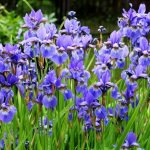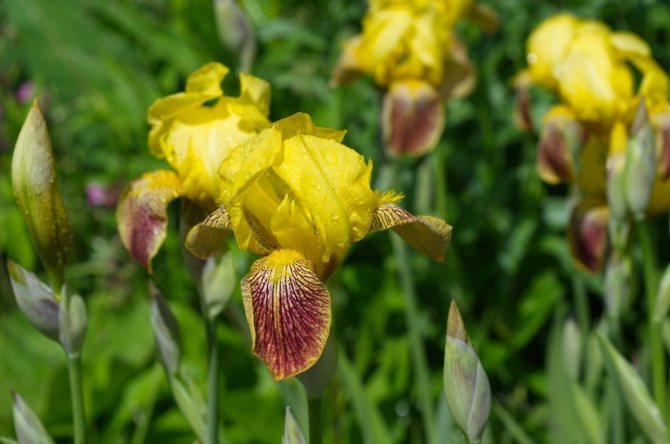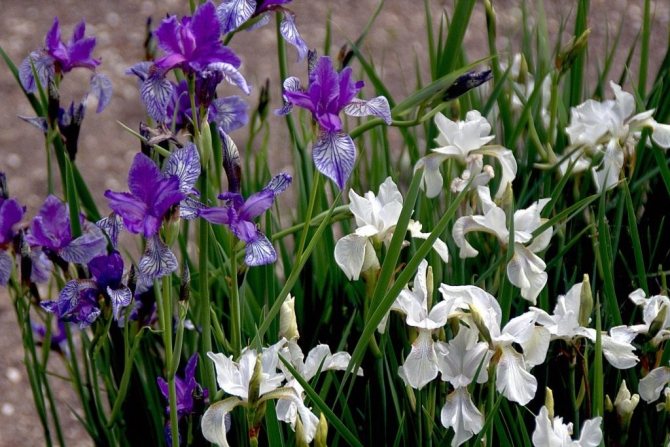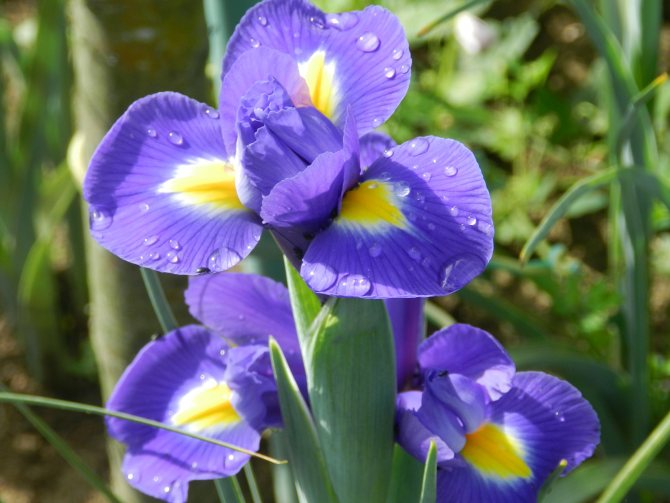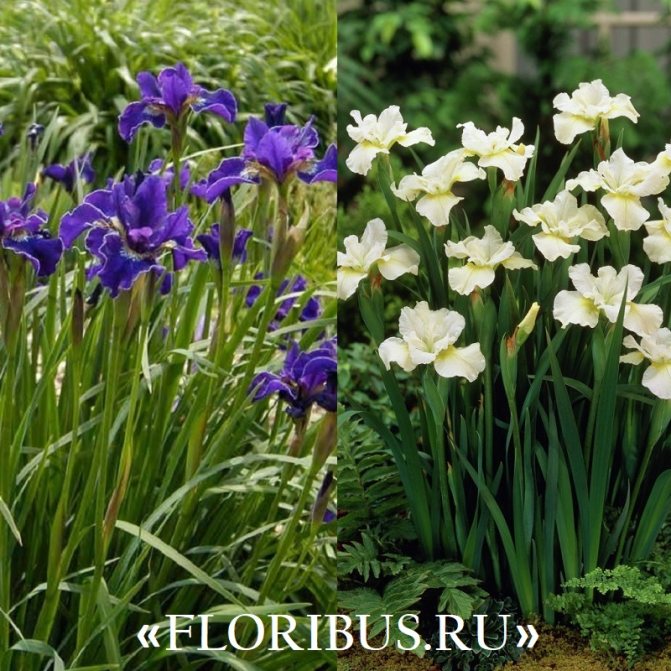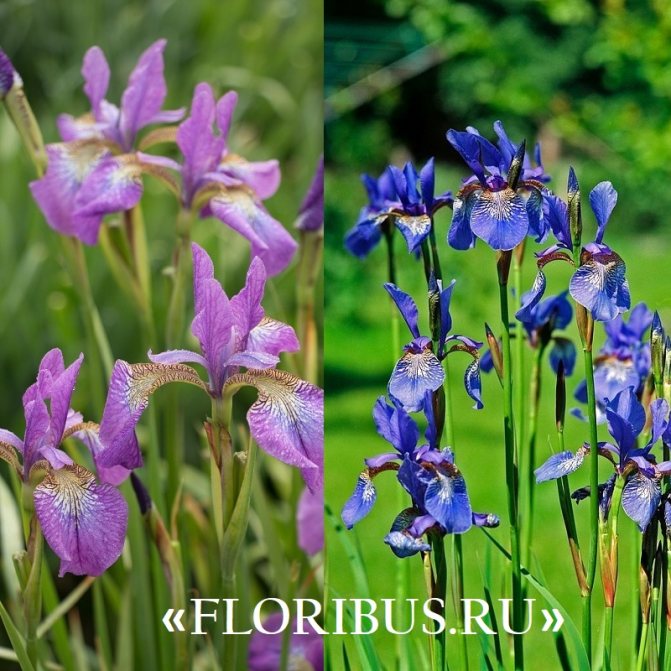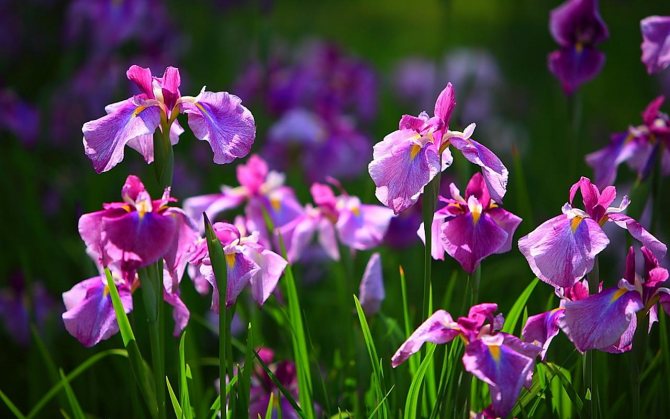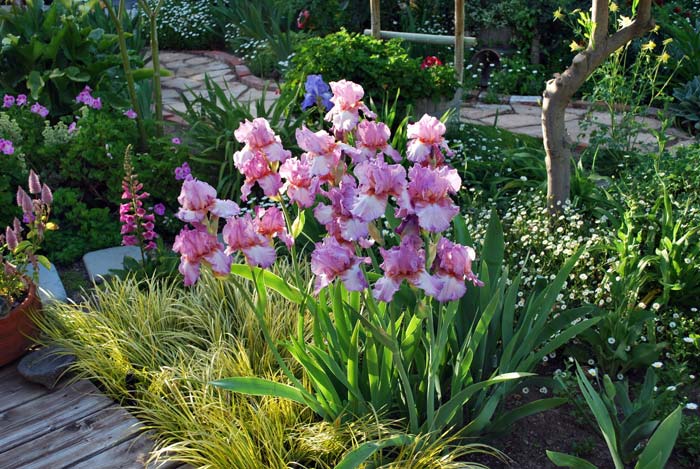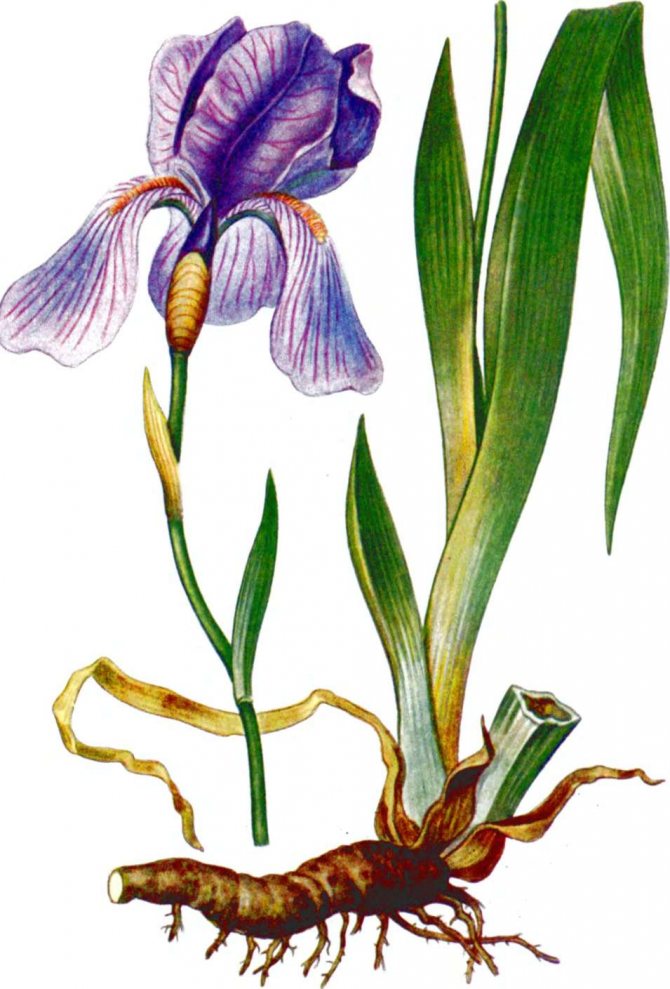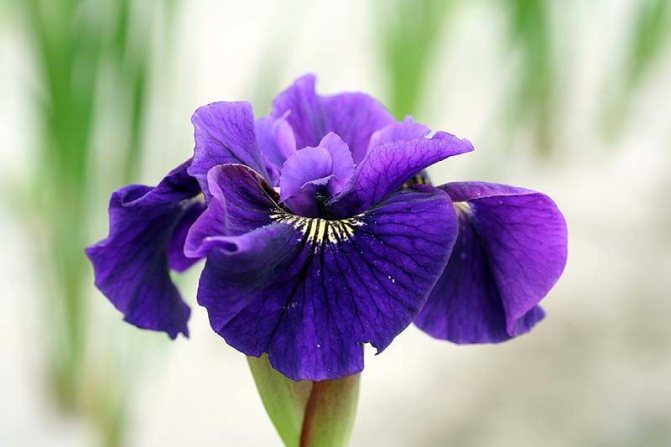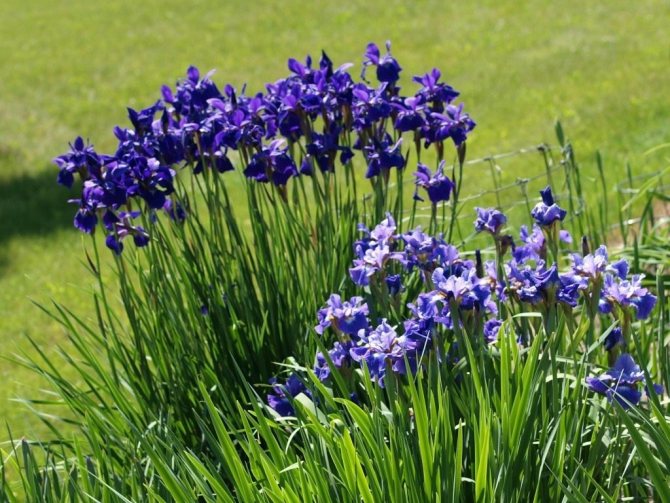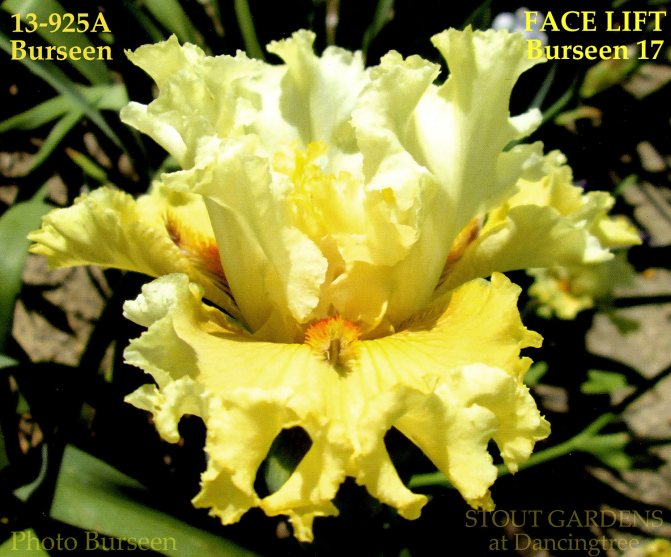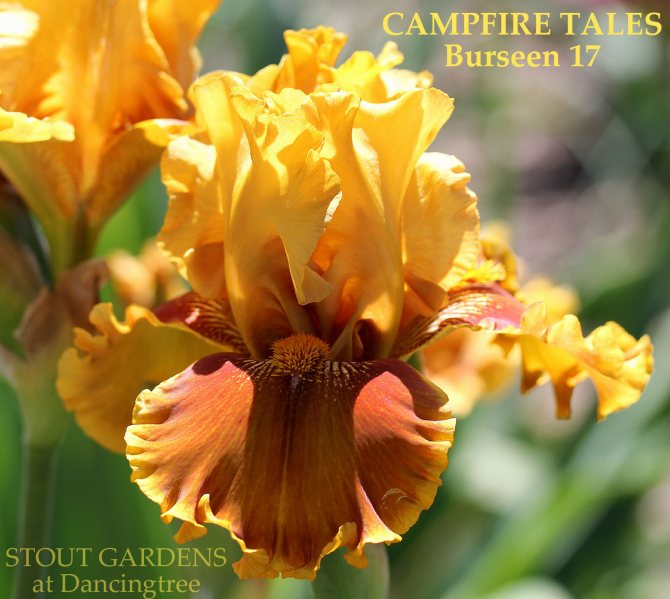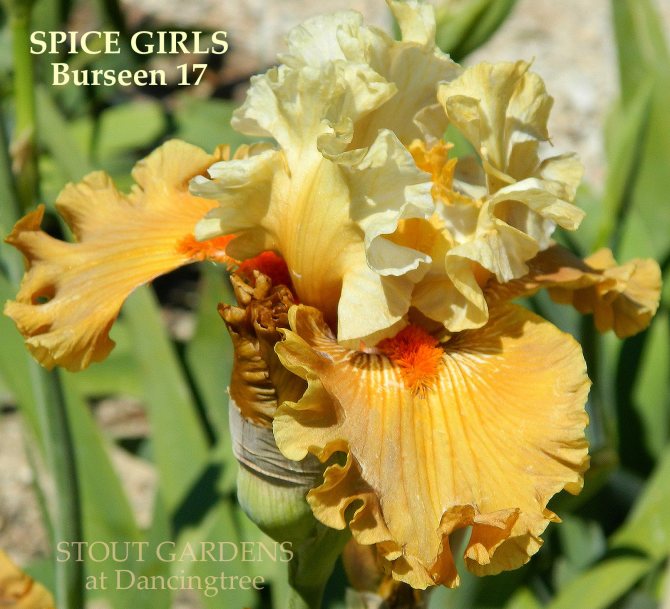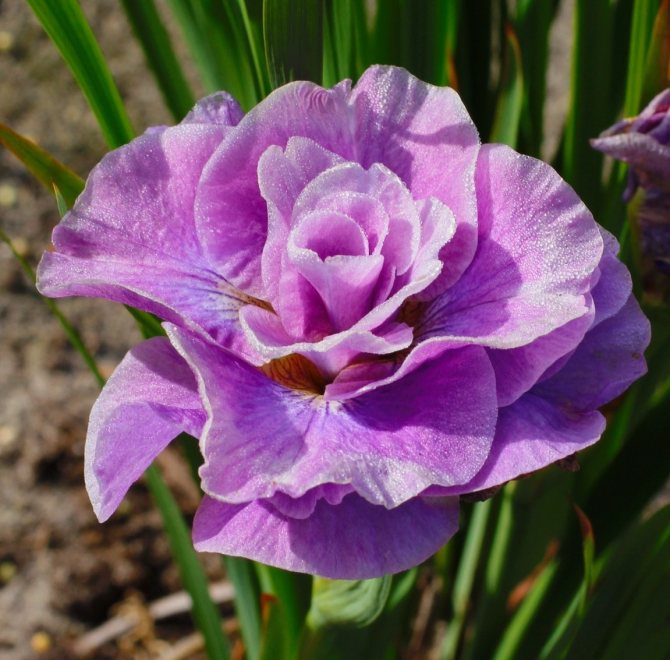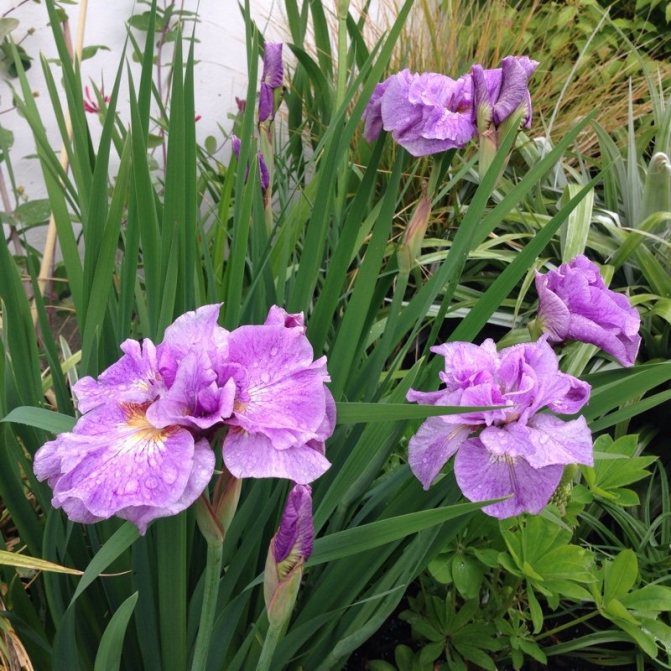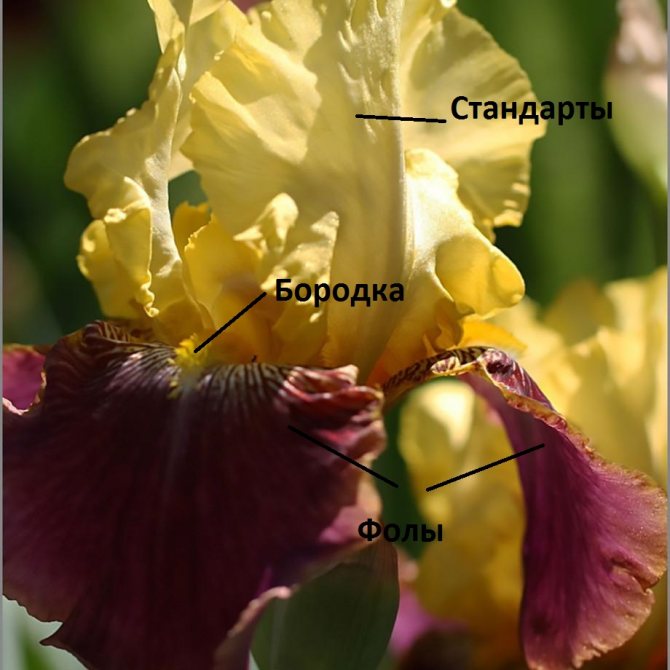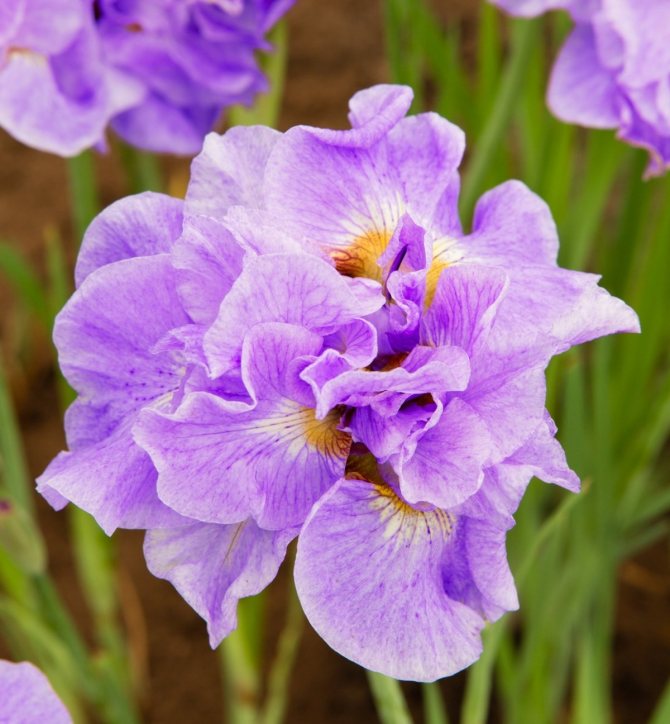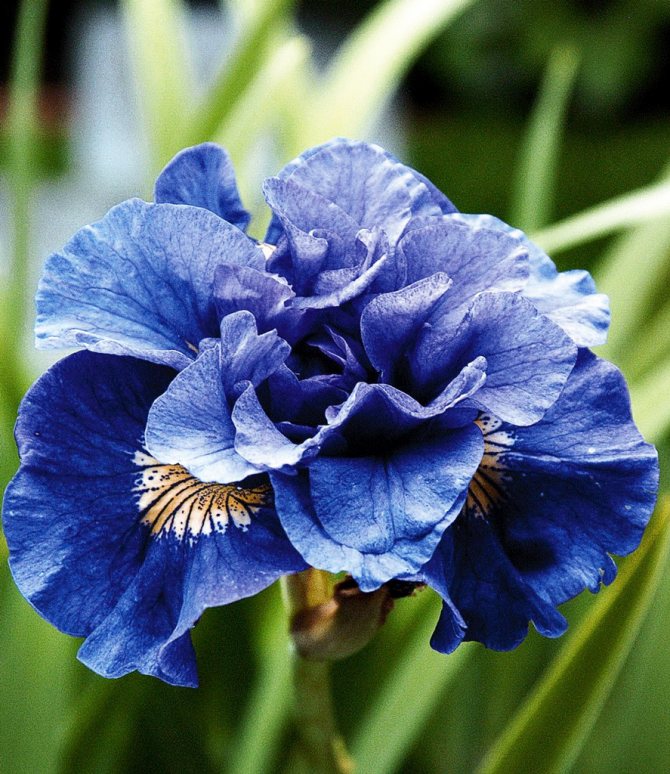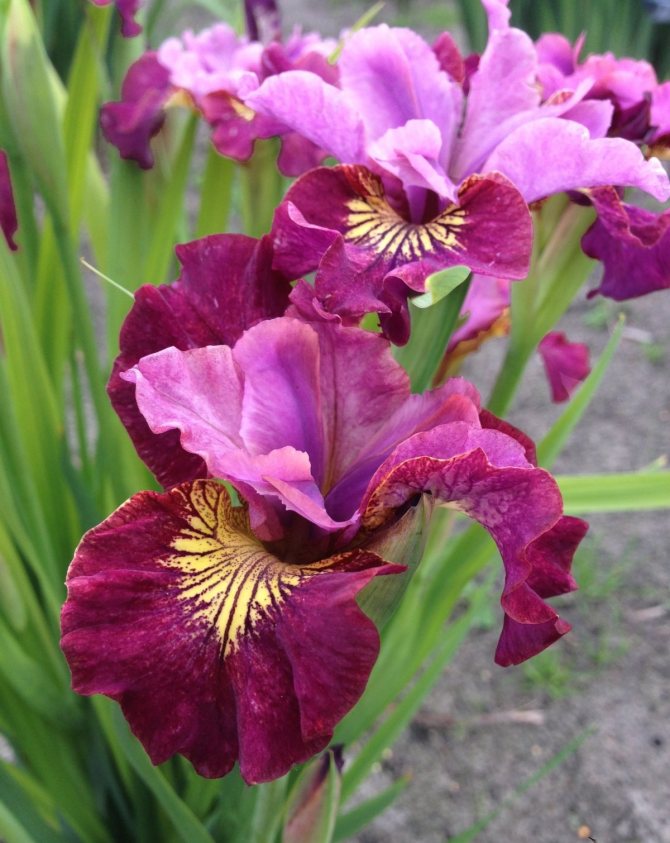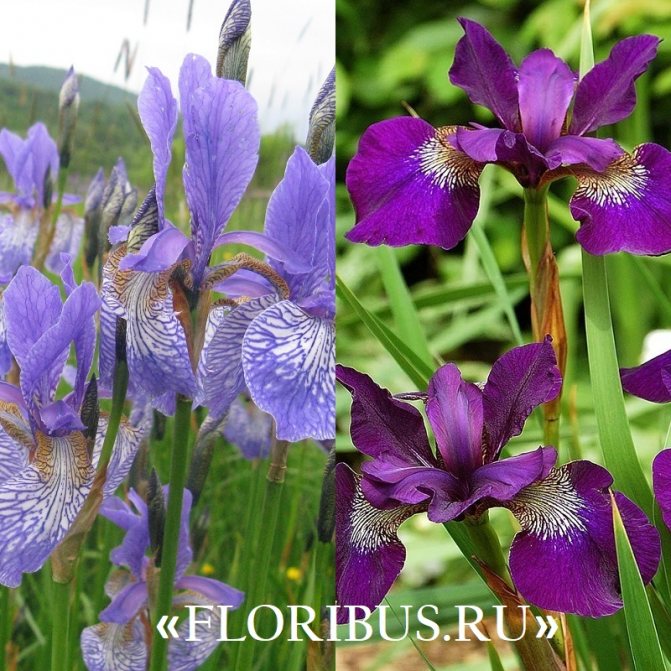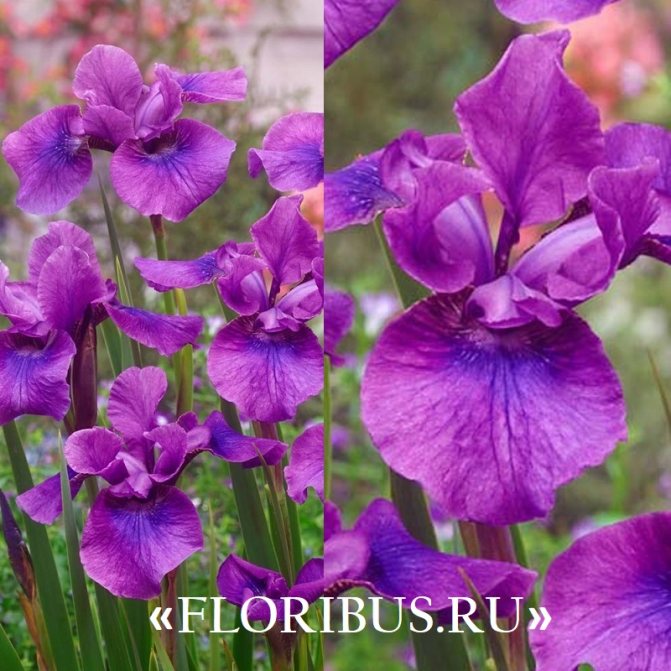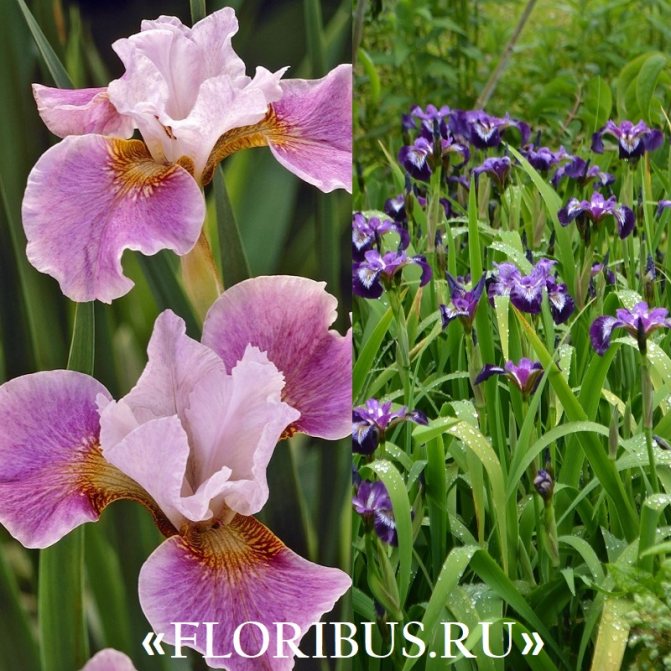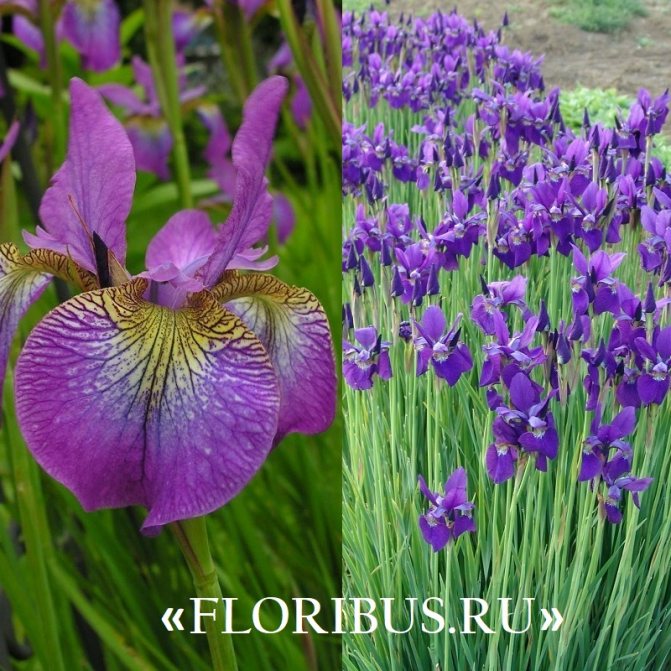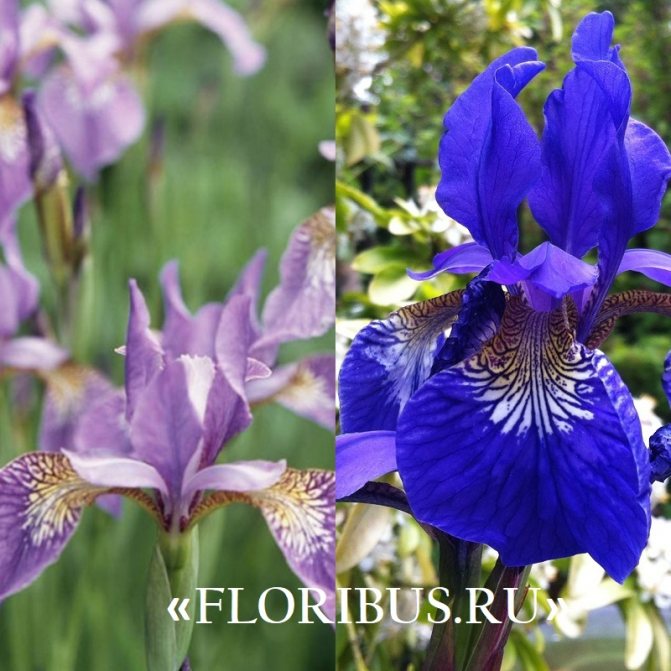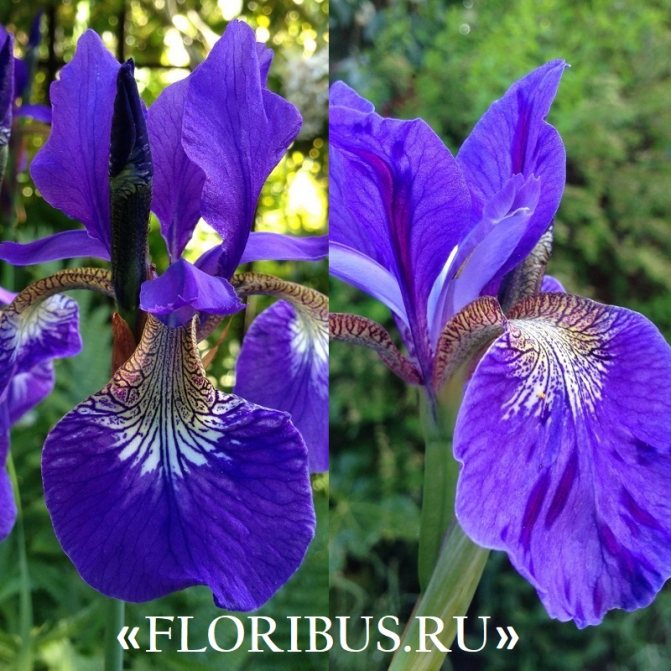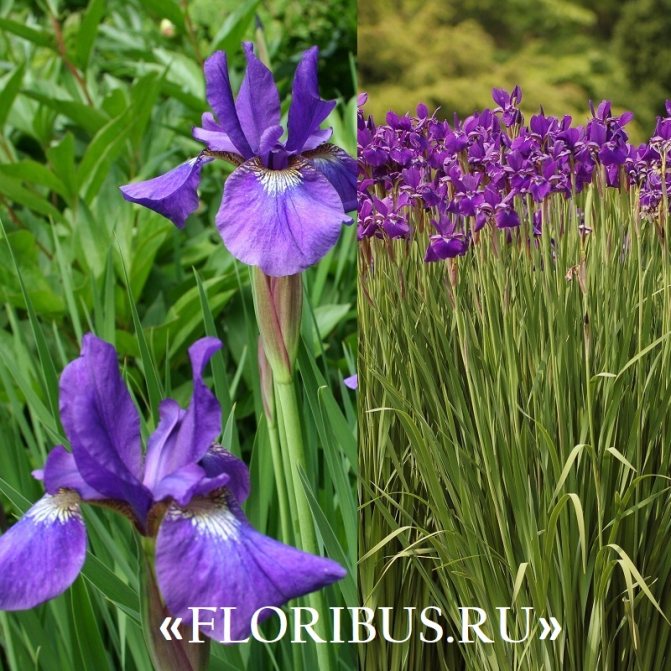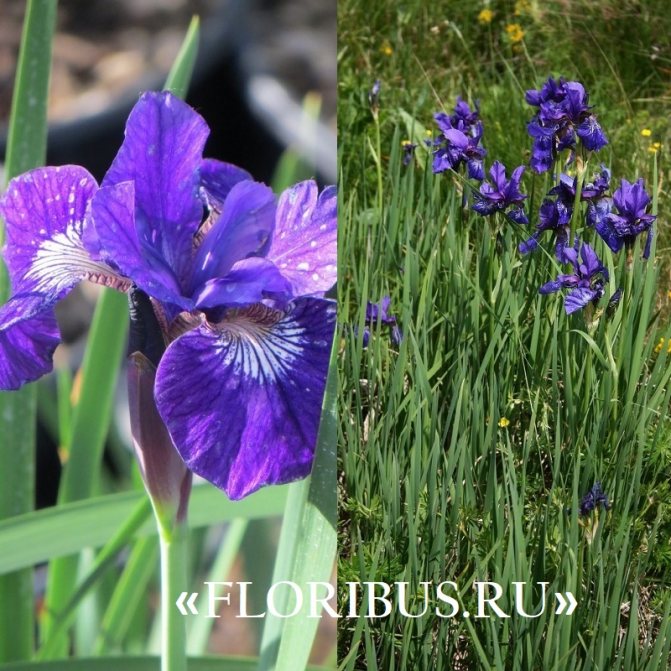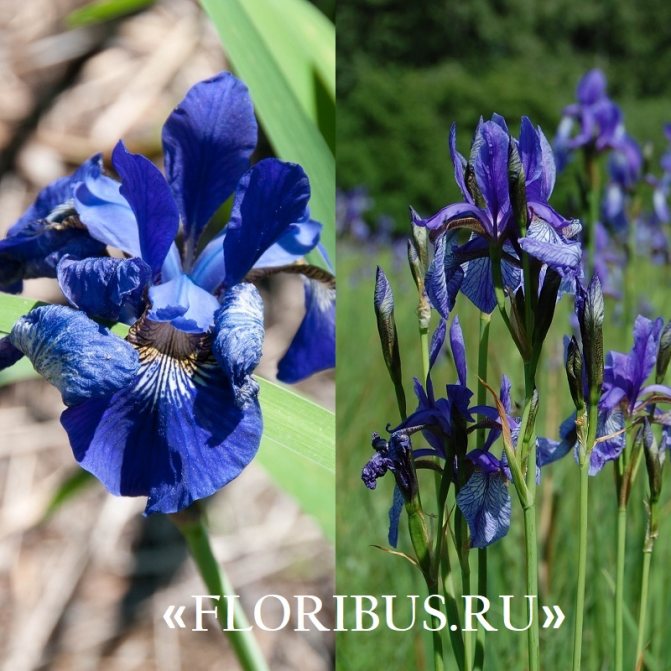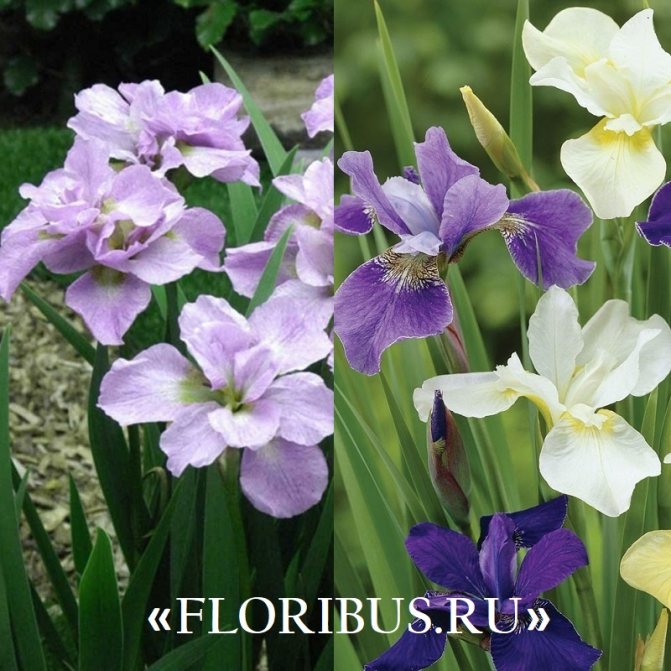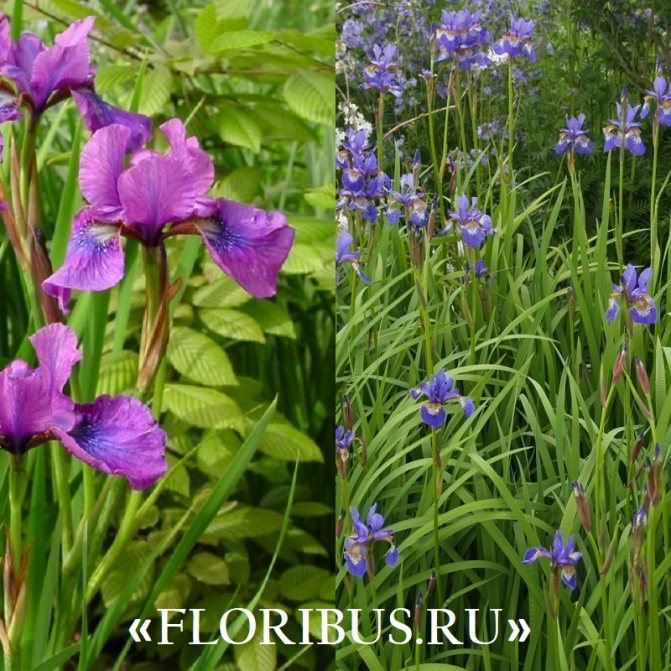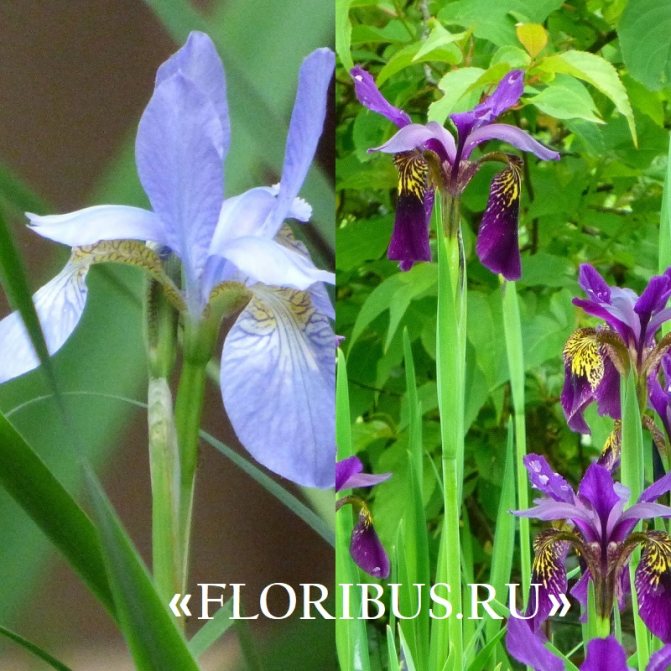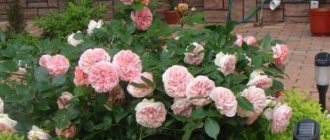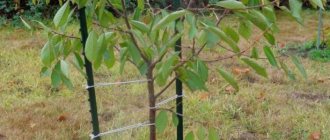Siberian iris - a real decoration of any garden. The plant is so rich in varieties in terms of color that, therefore, perhaps the Greeks gave it the name "Rainbow". It was believed that the goddess Iris, descended through the rainbow to Earth, gave all the colors to this particular plant.
All the irises that exist were divided by experts into groups with one feature - the presence of a "beard" on the outer petals of the flower. The groups were simply named: bearded and not bearded.
Siberian iris belongs to the non-beard group. They are the most common. There are three types in this group. The article is all about Siberian iris, description species and its qualities.
Siberian iris - description
The culture belongs to the category of perennial plants. She can bloom and delight the eye with bright colors for more than a dozen years. Iris or Siberian iris is bred even in the northern regions of Russia, because it is resistant to cold weather and various diseases. The common color of the buds is light blue or blue. Less common are varieties with milky, cream or pink petals.
The only drawback of Siberian irises is the lack of smell. However, it is offset by abundant and vibrant flowering. Each bud has six petals, three of which point downward and the rest point upward. The blooming period of the Siberian iris is from 12 to 15 days. In order for the culture to delight the eye with bright colors for a longer time, you can plant various varieties with an early and late growing season next to it.
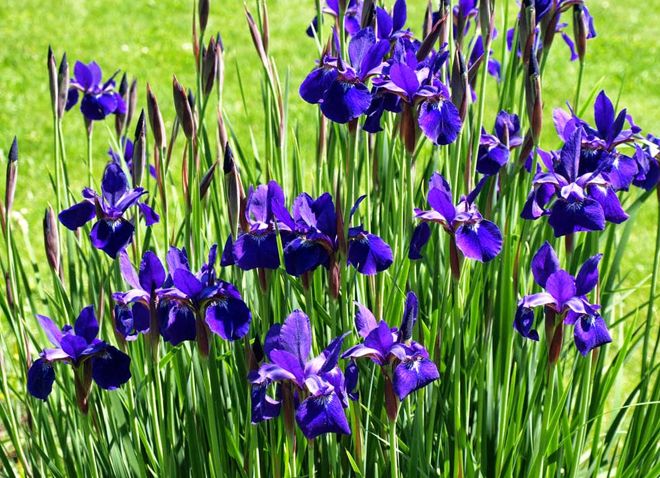
When does Siberian iris bloom?
The varieties differ not only in the shade of the buds and in height, but also in the growing season. The hybrid white Siberian iris blooms in June. However, most varieties bloom in July-August. The flowering time depends on the variety and on where the crop was planted. The less sunlight a plant receives, the later it blooms and the fewer buds appear on it. Breeders have bred remontant varieties, which bloom twice a year - in spring and early autumn.
What is the difference between bearded iris and Siberian?
Flowers of this type are divided into two large groups: with and without a beard. Siberian iris belongs to the second category. It differs from the bearded (Germanic) varieties in that it is unpretentious to the conditions of detention: it grows on soils with any acidity and can bloom even in partial shade. Another distinguishing feature of the iris is the absence of a jointed neck. Unlike bearded irises, Siberian irises do not tolerate fertilizing, which contains calcium.
Both plant varieties are resistant to root rot caused by fungal pathogens. Flowers also differ in the external characteristics of the buds. The flowers of the bearded iris have nondescript shades. Iris buds are distinguished by bright colors. They attract the eyes of others, but they are small in size. Yellow Siberian iris is less common in nature.
Description
The elegance and sophistication of the flower forms attracts the attention of this flower. The narrow, long leaves give the bush a graceful look. Such a bush looks great on any flower bed, along the hedges. A good bush and in a single planting.
The inflorescences of the plant are not so large in comparison with garden irises. But there are many of these inflorescences in the bush, and this distinguishes it favorably.The older the bush, the more inflorescences. There are varieties in which all flowers bloom at the same time and there are those in which blooming takes place in turn.
Therefore, some bushes look like a huge bouquet, while others bloom for a long time and delight with their beauty for a long time. This property of irises can be used in design.
More than hundreds of different types of Siberian iris are known. They are different in height, shape and color of flowers and leaves. They have different flowering periods. But they all have many of the same advantages over other species, due to their special properties.
Siberian iris varieties
A distinctive variety of winter-hardy plants is neat leaves and a high stem (up to 120 cm). In order to better familiarize yourself with the features of the plant, it is necessary to consider the most popular varieties that gardeners love:
- Alba
... The flowers are lemon-creamy. They bloom in early summer and may not fall off for a long time even in bad weather. - Ego
... Belongs to dwarf breeds not exceeding 80 cm in height. Siberian blue iris blooms in July, but no buds are observed in the first year. - Big Ben
... Iris is distinguished by its bright purple color of buds, reaching 7 cm in diameter. Grows well only with enough light. - Double Standard
- Terry iris flowers have two shades: lemon in the middle and dark purple at the edges. Their blooming is observed from July to August. - Concord Crash
... In terms of external characteristics, the flowers resemble the Double standard variety, but they bloom much earlier. Iris Siberian Concord Crash blooms in late May and early June. - White Swell
- a dwarf variety that grows up to 60 cm. The buds are distinguished by snow-white shades without blotches and additional flowers. Iris grows exclusively in sunny areas. - Cambridge
... The buds of irises have a pale blue tint with a yellowish spot at the base. They need sunlight for good flowering.
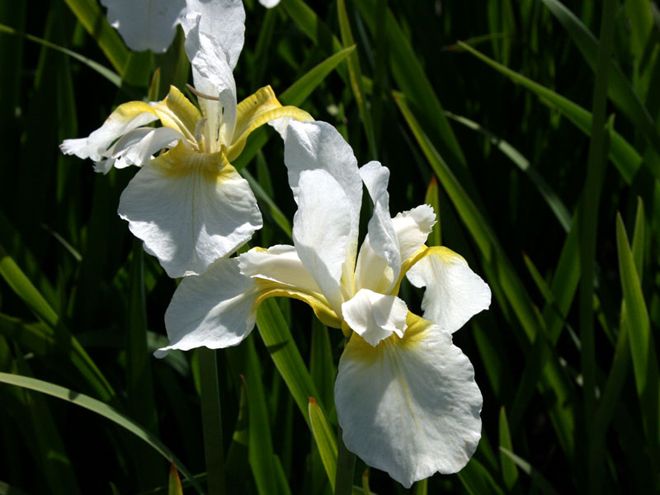

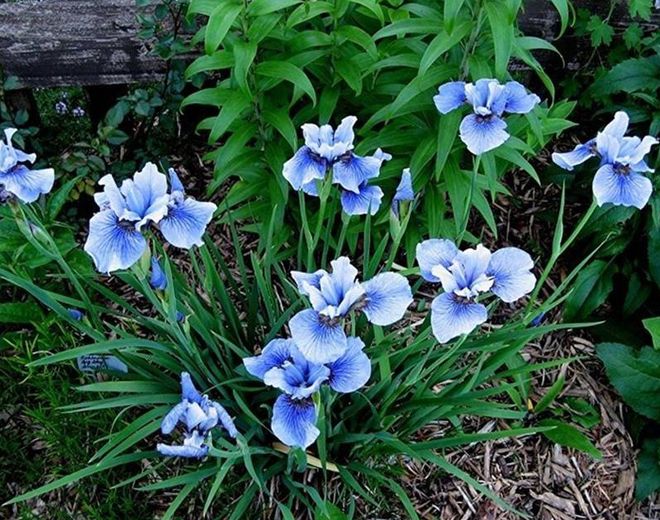

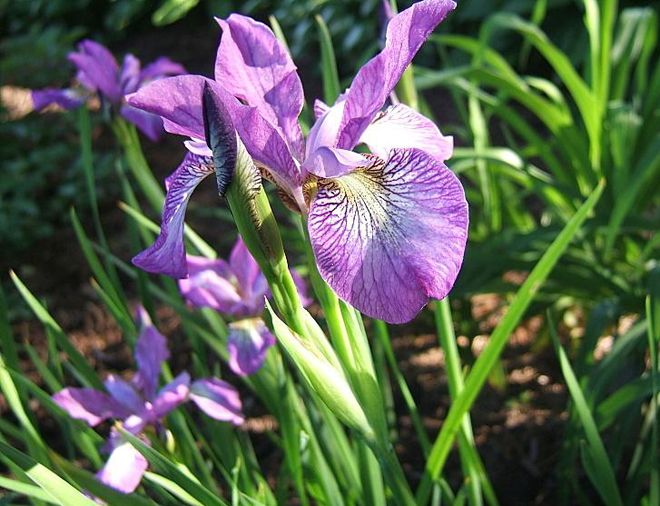

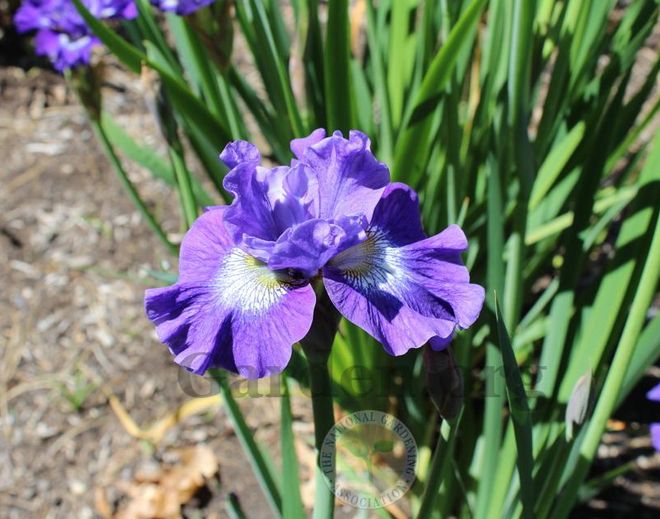

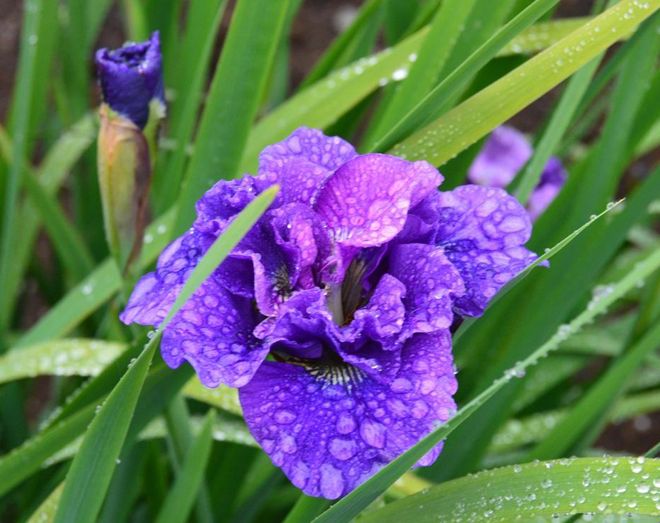

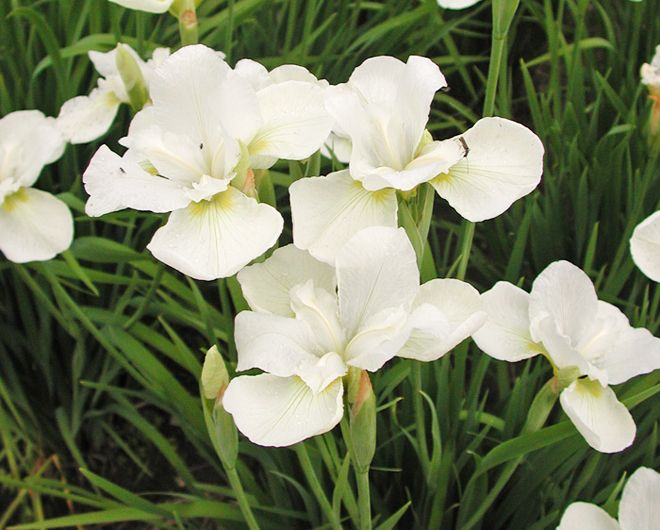

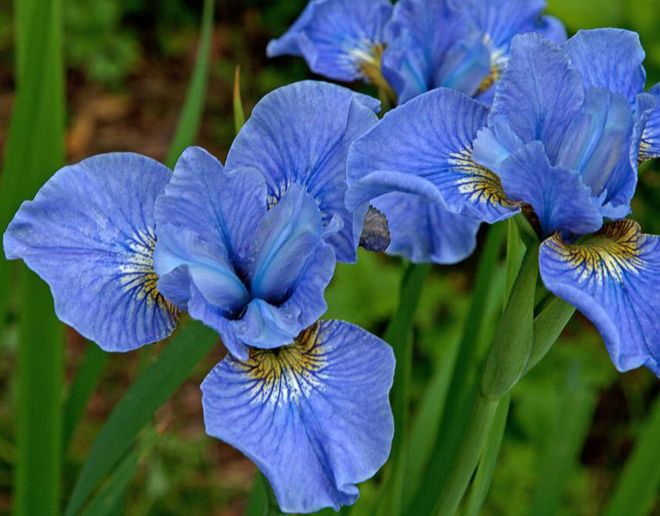

Types and varieties of Siberian irises (names and photos)
Most often, blue Siberian irises are found in nature, therefore they are considered the main varietal group. After flowering, the fruit is formed - a dull box with numerous seeds.
The Siberian-Far Eastern hybrid has become widespread in Russia, namely in the Far Eastern part of Siberia. It differs from the main species of Siberian irises in that its leaves are not much narrower and the wrapper plates have a reddish tint at the base. The flowers of the plant, as we will see in the photo below, are of blood-red color scheme. Plants of the species reach a height of about 80-90 cm. Leaves and shoots are about the same length.
Another species that is usually considered to be among the Siberian group of irises is the cattail, not so long ago discovered in the Far East. In Russia, it did not spread widely, but in China, Mongolia and Korea it is often found. The flowers of the species are white or with a lilac tint. Basically, the species is represented by dwarf varieties, no more than 30 cm high. The most famous variety widespread in Russia is the Siberian white iris "Nana".
There are many more species that belong to the Siberian group of irises, namely:
- "Zolotistispisanny" - buds from black to creamy purple, plant height up to 40 cm;
- "Clerk" - buds from purple to deep blue, bush height up to 60 cm;
- "Delavea" - a kind with lilac flowers of dark or light tone, the length of peduncles and leaves up to 50-60 cm;
- "Dyksa" - violet-purple dark, very rich buds on the stem up to 100 cm;
- "Bulla" - dark, almost black buds with a purple tint. Like the Dykes species, it rarely appears in garden compositions, practically never occurs in nature. Both representatives are listed in the Red Book in many regions. There is an opinion that these are representatives of natural hybridization;
- "Forresta" - very fragrant, up to 40 cm high;
- "Wilson" - like the "Forrest" species, has a pleasant smell of inflorescences, but much larger - it reaches a height of up to 1 meter;
- "Reed" - mainly found in China, namely in the southwestern part of the country. The varieties of the species are presented with blue inflorescences of medium-sized buds.
For cultivation in Russian gardens, varieties with a white or creamy shade of buds are often used. True, such flowers stay a little less, due to some factors, especially when placed in the sun. White Siberian irises are Frostyd Emerald, Rolling Cloud and Wide Prelude, but these are just a few of the great variety. Yellow flowers are found in the Siberian iris "Moon Silk", the petals of the plant seem to glow with the moonlight, so the culture received this name. Also, inflorescences of yellow tones are found in the following varietal groups: "Just Cruising" and "Sunny Spells". Popular Siberian irises with blue and violet colors: Berliner Wells, Magnum Bordeaux and Jings.
In the photo below we will see even more popular varieties of this plant variety:
In Russian gardens, the variety of Siberian iris "Imperial Opal" is very popular - this is a plant with lilac inflorescences of 2-3 buds. Flowering is not long, one-time, but very effective. It is rarely found in nature, in gardens it is used as a frost-resistant delicate plant with densely double corolla petals.
Siberian iris - planting
The procedure is carried out in August or early September, but the first decade of May is also allowed. Planting outside of the schedule can cause disease and death of the flower. Crops placed in open ground in late autumn are more difficult to adapt to external conditions. These rules apply to all varieties, regardless of whether Siberian yellow or white iris is planted. A distance of 60-70 cm is left between individual specimens.
Holes are made in a pre-prepared area. Their depth should correspond to the length of the roots of the irises. It is important that they do not bend or break. The seedlings are placed vertically, and then sprinkle them with soil and tamp the soil around the flower. After planting, the plant is watered. In order for the plant to take root better, the ground around it is covered with mulch: peat or compost.
Soil for Siberian irises
Perennial crops grow for a long time in the same garden plot, therefore it is recommended to plant them in fertile soil. Flowers, especially Siberian iris Lemon Veil, prefer loamy soil with a neutral or slightly acidic composition. It is recommended to add sand to heavy soil before planting a crop. It's important not to overdo it. Too much sand will negatively affect the growth and fruiting of irises.
Other soil correction rules for planting crops:
- in marshy areas at the site of iris planting, high-quality drainage is organized;
- organic fertilizers and clay are added to sandy soils;
- peat is introduced into the earth with an alkaline environment.
Reproduction, planting and transplanting
Of all the groups, it is Siberian irises that are not considered picky. Their planting, transplantation and reproduction do not cause almost any inconvenience. For this, it is important to know some of the nuances and advice of experienced florists. Firstly: an important aspect is the correct choice of soil for planting irises - they do not tolerate heavy, acidic and wet soil mixtures.
The soil for the plant should be slightly acidic, preferably with a high lime content. Nutrients are introduced in large quantities when digging a site for planting.
At this time, you can adjust the compositions if they are not favorable for growing members of the group. An equal amount of sand and peat is added to clay mixtures - this will make the soil lighter and more nutritious, and also improve its water permeability. Sandy compositions are weighted with a small amount of clay and enriched with organic fertilizers.If you use nitrogen-containing dressings, then you need to be as careful with them as possible, since excess nitrogen at a young age has a bad effect on the immune system of adult plants. Sour soil is lime.
The place for planting Siberian irises should be well lit by the sun, but so that in the midday heat the plants are in an openwork shade. Therefore, they are recommended to be planted next to large plants, such as shrubs or trees with a lacy crown. With strong shading, the culture does not suffer, but it does not bloom either. Unlike other species groups, the Siberian iris is not affected by winds and drafts. It does not require protection from gusts of air, since the leaves do not fall, except perhaps from a hurricane.
When planting or transplanting a plant, its rhizome deepens into the soil so that there is about 3-5 cm of soil to the surface. The roots of Siberian irises love coolness, so after planting the divisions in a permanent place, you need to mulch the plantings with leaves, peat or any other materials at hand. The pits for planting should be suitable for the size of the planting material. When planting in the ground, make sure that the root shoots do not bend.
Siberian irises care
Growing iris includes loosening the soil, weeding, sanitary pruning and feeding. Siberian iris planting and caring for which, will not cause difficulties, needs regular watering. The flower does not like dry conditions. You should not pour irises, because in this case weeds will actively grow. A good time to moisten the soil under the crop is early morning or evening.
Siberian iris - top dressing
Fertilization is another important plant care routine. Some varieties need to be fed once a year. Siberian iris Kabum requires fertilization in several stages:
- When the first greenery appears on the bushes. In this case, minerals are used: Kemiru.
- During the period of bud formation. Use compost or fermented grass.
- After flowering, phosphorus-potassium substances are introduced into the soil.
How to care
Caring for irises does not require a lot of time.
Soil selection
The most favorable for most varieties of iris is the soil with an alkaline or slightly acidic environment, as well as a good drainage layer.
If the soil on your territory does not meet the requirements, then you can always find ways to improve the existing one. Is the soil heavy? It doesn't matter, just add sand and peat. But what if sour? Then lime will come to the rescue, which, for sure, you will have in stock.
Location and lighting
Light-loving irises should be planted in areas with the most sun. It is necessary that the area selected for planting be away from groundwater. It is desirable that there is a small hill at the landing site, then the irises will feel most comfortable.
Temperature, humidity, watering
Irises are thermophilic plants. For growing in regions with cold winters, it is recommended to choose frost-resistant varieties.
Gardeners should control the amount of water that the iris receives during the budding period: during this time, watering should be abundant. Fortified plants are watered only when the soil around the root system is completely dry.
Excessive watering will lead to the formation of rot.
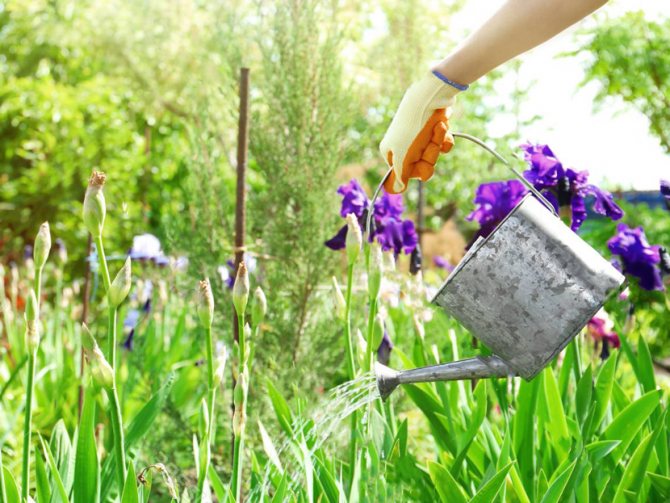

Fertilizers and feeding
When preparing the site for the spring planting of flowers, gardeners usually cultivate the land and add nutrient solutions to it. In most cases, these micro and macro elements will be sufficient for the normal growth and development of irises.
If the flowers have begun to fade, then after flowering, they can be fed with a small amount of fertilizer, which includes elements such as potassium and phosphorus.
Pruning
Due to the fact that the root system of irises develops horizontally, it can be damaged inadvertently during weeding, so this process should be carried out carefully, manually.
In bulbous species, at the onset of autumn, be sure to remove yellow leaves with brown spots.
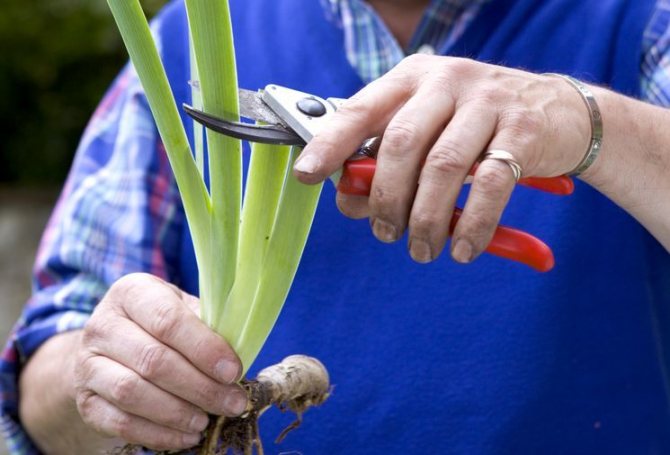

How to prepare for winter
Many Siberian and bearded irises are cold-resistant, so there is no need to dig them out before winter comes. If the winter is expected to be warm, then the plants need not be covered.
However, irises of the first year of planting and old plants in which the tuber is not completely covered with soil, it is better to prepare for the cold. To do this, the soil around the plant is mulched, and the bushes themselves are covered with straw.
In early spring, remove winter mulch and straw so that the plant can grow and develop freely.
As for the bulbous irises, they are very susceptible to a drop in temperature, so after the leaves turn yellow, the plants should be dug up, dried and stored in a cool room until spring.
When to plant
The optimal time for planting plants is the second half of August and early September. The root system manages to get stronger enough before the onset of the growing season.
When to transplant Siberian iris?
In one area, the culture cannot grow for more than 15 years. The roots of old bushes take useful trace elements from the soil and prevent the seedlings from developing normally. Some varieties such as Siberian iris Imperial Opal. transplanted every 5-6 years. They try to remove old rhizomes from the soil so that they do not take up space. The optimal time for transplanting iris is 2-4 weeks after the petals wilt.
Algorithm of the procedure:
- Peduncles and leaves are shortened by 1/2 length.
- The iris is divided into several bushes and planted in new areas.
- The seedlings are buried in holes 5-7 cm.
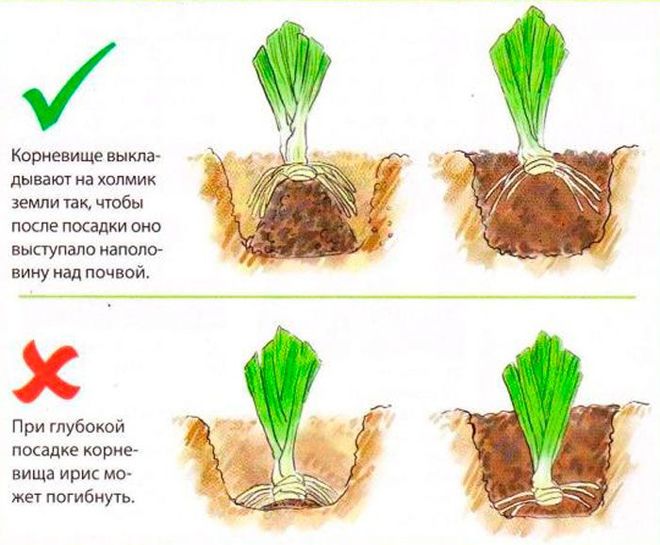

Iris "His"
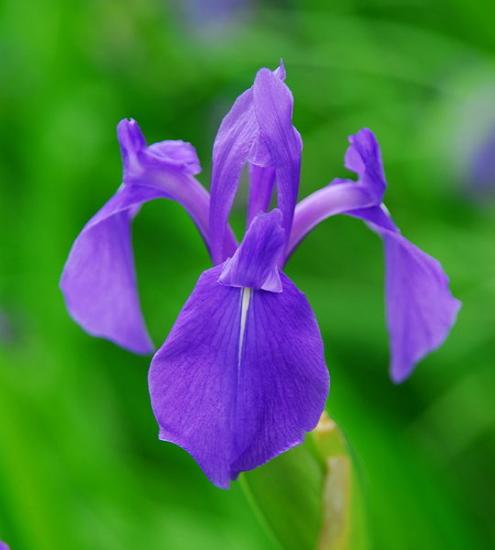

Iris Ego is a classic iris with delicate blue flowers, a thin stem and light green leaves. Gardeners prefer this species because of the dense, well-formed shrubs that look neat and flower all summer.
"His" has a powerful root system, so it loves well-fertilized soil, light and moisture. A good landing site will be the edge of the reservoir, or a point above the water level.
Siberian iris - reproduction
The procedure is carried out with rhizomes, not seeds. This is due to the fact that in the latter way it is impossible to transfer all the genetic material of the parent seedlings. This method of reproduction is suitable only for those varieties that are bred by breeders: Siberian iris Ice Stars, Big Ben, Alba Natural species have the ability to self-pollinate. Their seeds, falling to the ground, germinate and give the first shoots in the spring.
Irises growing in the wild are not suitable for planting in a summer cottage. This is due to their uncontrolled reproduction. Stages of the procedure:
- The bush is dug up and its rhizome is shaken off from the adhering clods of earth.
- The roots are divided into parts. It is easier to perform manipulations with 3-4 year old specimens. It is more difficult to divide mature shrubs, because their roots are strongly intertwined with each other.
- At the planting unit, the roots are cut (5-7 cm) and the leaves are 2/3 of the length.
- Delenki are immediately planted in a new place or buried in the ground before being placed in the ground. Otherwise, they will dry out and become unusable for further use.
Cultivation of Siberian irises
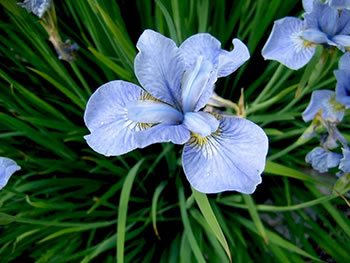

Siberian irises exquisitely beautiful, few people can remain indifferent to the bizarre lines of flowers, silky petals, as if painted by a mysterious artist. These irises do not freeze in winter, they can bloom magnificently for decades, rarely get sick. And the hybrid varieties that have appeared are also pleasing with the richness of color. If the petals of natural species are bluish lilac, then varietal ones can be white, yellow, pink, purple, the color can even overflow from one tone to another.
Siberian irises, despite their name, do not grow in Siberia, but in northern Italy, eastern Switzerland, the Baltic states, Western Belarus, in the high-mountain meadows of the Caucasus and Turkey. We meet in the south of the Arkhangelsk region and in the Komi Republic. And in Siberia, the blood-red iris grows.
It was these two species that became the first parents of hybrid varieties of Siberian iris. Then there were many more crosses, as a result about 800 hybrid varieties were bred. Considering that breeding work has been carried out since the middle of the last century, the result has been significant.
If the wild-growing iris produces a straight peduncle bearing no more than three flowers, then among the hybrids there are varieties with branched stems that adorn up to seven flowers, which significantly lengthens the flowering period.
A classification of hybrid Siberian irises has already appeared, based on such characteristics as color, shape and size of flowers, height of peduncles and flowering time.
Eyes, set pieces and fouls
The classic Siberian iris flower consists of three narrow petals directed upwards (standards) and three wide lower ones (fouls). There is a contrasting spot near their base - an eye. In hybrids, all petals can be wide, and all of them are directed downward or upward. There are varieties with double flowers or corrugated edges of the petals. The size of the flowers varies from 5 cm to 16 cm.
Breeders have done a lot of work with the color of the petals. They can be of the same color, without spots or borders: white, blue, blue, purple, cream, yellow and even pink, crimson and wine red.
The upper and lower petals come in different tones of the same color or different colors. For example, the top petals are white or light blue, while the bottom petals are yellow, blue, pink, or purple. In some varieties, the color of the petals is difficult even to describe - several flowers smoothly flow into each other.
A great advantage of Siberian irises is the strength of the stems, even at a height of 70-120 cm they do not need support. Medium-sized irises (50-70 cm) are perhaps the most popular among summer residents, and undersized (25-50 cm) and dwarf (15-20 cm) are often planted in parks.
Hybrid Siberian irises are also distinguished by flowering time. There are varieties that bloom in June, but most bloom in July-August. Irises, planted in the shade, bloom later. There are remontant varieties that bloom twice a season: in spring and autumn.
Multicolored iridarium
To give you an idea of the beauty of hybrid irises, we have grouped the most popular varieties by color and present them to your attention.
FLOWERS WHITE: Butterfly Fountain, Belissima, Easter C.D. Em, Snow Prince, White Lance, Forfold White, Harpswell Shan-tez, Shirley Choice, Aeol (domestic variety).
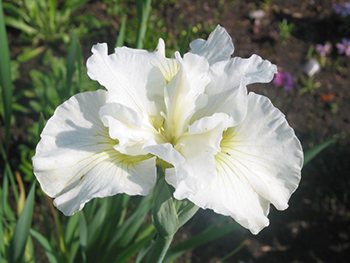

Belissima
YELLOW: Butte End Cream, Butte End Suga, Dane Suzie, Dreamin Yellow, Isabelle, Moon Silk, Sunny Spels.
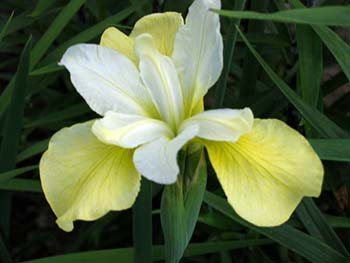

Butte End Suga
PINK: Valley of Delight, Jax Health, Dawn Walte, Mary Louise Michie, RoaringJeli, Spuckling Rose, Frostyd Cranberry, Heath Wave.
Spuckling Rose
PURPLE, RED-PURPLE, WINE-RED: Ani Marie Troger, Blackburn Jubilee, Jamykin Welwit, Jeweld Crown, Indy, Lady Vanessa, Owil Faye, Plum Frolik, Sweet Sarrander, Hubbard, Active Duty.
Lady Vanessa
BLUE, BLUE: Vicky Ann, Lady of Quolity, Lilting Laura, Mae Love, Riverdance, Sally Carlin, Silver Edge, Super Ego, Steps In Blue, Tweed.
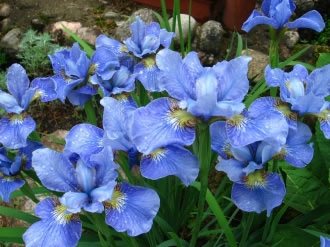

Vicky Ann
BLUE PURPLE, PURPLE: Liberty Hills, Rafld Welwit, Raflds Round, Reprise, Saltans Ruby, Silver Edge, Super Ego, Toropyzhka (domestic variety), Trim The Welwit, Rearwood, White Conner Swee, High Standards, Caesare Bryze, Domestic Rigel, Edu grade).
Rafld Velwit
TRANSFERRED: Blackburn Jubilee, Book of Secrets, White Emba.
TWO-COLOR: Dane Balerine Dane, Shakers Prace, Orientel Cap, Hantis.
By the way!
In Siberian irises planted in partial shade, flowering is a week late compared to plants of the same variety growing in a sunny place.In heavily shaded areas, there will be no flowering.
Choosing a place of residence
Since frequent transplants of Siberian irises are laborious and undesirable, before planting, you should think about where to settle them. For some reason, it is generally accepted that they love the shadow. In fact, these irises bloom best in areas that are well lit by the sun. Indeed, in nature, they are found along the edges of the forest, in forest glades, floodplain meadows. Therefore, in the garden it is necessary to find a place for them, sufficiently illuminated by the sun, at least half the day.
When planting in a very sunny place, trees and shrubs can become protection from the stinging rays, giving a slight shade. In this case, irises should be planted at a distance of 2 m from them, as their roots dry out the soil.
Siberian irises thrive in humid places, but on excessively moist soils, drainage is required to plant them. They can grow in elevated dry places, only then they should be watered more often, especially during flowering. Surprisingly, these irises can even grow on a rocky hill. Low-growing varieties are suitable for such a planting.
Since Siberian irises have strong stems, they can be planted in areas that are open to all winds. Bushes with powerful foliage and strong peduncles successfully resist the wind.
We select neighbors
In mixed flower beds (mixborders) Siberian irises feel great, because they come from meadow species, where they grow together with daylilies, catchments, acanites, delphiniums and lilies. White and blue varieties of Siberians look especially good against the background of orange swimwear.
In complex flower beds you can plant Siberian irises in low places, where the soil level is below the rest of the surface by 10-15 cm. Thanks to this trick, the decorativeness of the flower garden will increase, since the height of Siberian irises will visually decrease. In addition, such plantings are very convenient for overflow watering.
For group boarding only irises need to be selected in such a way that they all bloom at the same time and harmonize in color. Irises of different shades of the same color look beautiful. In this case, the plant with the lightest flowers should be the tallest.
The Siberian iris bush with its green fountains of leaves looks good on the lawn. Against the background of the lawn, a foppa of 3-5 different varieties can be formed. They can be combined with other perennials such as peonies, daylilies, hosts, oriental poppies.
Siberian irises look great against the backdrop of a lawn, but it is important to make sure that the roots of the grass do not get into the circle of irises and do not interfere with their growth.
Imagine how beautiful the composition with white or blue Siberian iris will be against the background of carved foliage and bright red flowers of oriental poppy. Such a group is also very effective: dark blue Siberian iris, white-yellow peony Claire de Lune and lupine with chintz color connecting them.
Siberian irises are simply irreplaceable for decorating reservoirs. Bright large flowers reflected in the water will not leave anyone indifferent. Their xiphoid leaves, resembling reeds, look very natural on the shore of a pond. And the high humidity of the air and soil creates the most favorable conditions for the growth and development of these beautiful flowers.
Soil preparation
Before planting, the soil must be prepared so that the Siberian irises will have enough nutrients for a long time. We remind you that in one place they can grow for 12-15 years.
Preparation should start with digging the earth and removing weeds, especially rhizomes, such as sow thistle, wheatgrass, creeping grass, bindweed, horsetail, which cause a lot of trouble for irises. Despite the fact that the highly developed root system of these flowers forms a very dense turf, even the rhizomes of weeds are taken into it and stitched through it. If there is a lot of weeds, you can clean the area from it with a roundup. However, this should be done a year before planting flowers.
Siberian irises grow best in neutral or slightly acidic soil (pH 5.5-6.5). If there is light loam on the site, and even rich in humus, then the land is the best suited for growing them.
Acidic and heavy soils are improved with lime and sand, and peat is added to alkaline soils to increase acidity. Sandy land is the poorest. Both moisture and nutrients quickly leave it. It is not easy to adapt such a plot for growing Siberian irises, but you can add 1 bucket of clay and 2-3 buckets of nutritious compost or peat with humus per 1 m2.
In peaty soils, irises also grow poorly, since such areas are too waterlogged and very acidic, but Siberians can also be grown there by making drainage and adding lime (300-500 g / m2). Clay soil is improved by adding, when digging, a mixture of river sand (13-15 kg / m2) and peat with humus or compost (1-2 buckets / m2).
What to look for when buying an iris
The rhizomes of Siberian irises do not tolerate drying out. Therefore, when selling, they suffer most often, especially if the sellers have not taken care of them. When buying, pay attention to the packaging of the planting material. The best option is the rhizomes of irises in pots, and it is more reliable if they are grown in domestic nurseries, and not in the greenhouses of Holland.
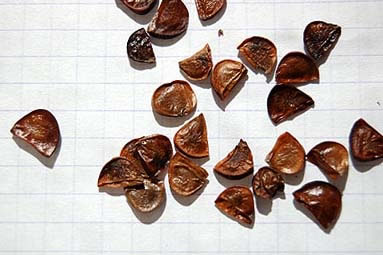

A good option if the rhizomes are placed in a plastic bag and sprinkled with sphagnum moss, which retains moisture well and is also a natural antiseptic.
Often, the rhizomes are simply sprinkled with peat - this is not the best option, since the roots often turn out to be dry, which is why the irises do not take root well and get sick for a long time.
And of course, do not buy planting material from random people in spontaneous markets. The chances that they will have varieties of hybrid Siberian irises are not only minimal, but we can safely say that they are zero.
We plant and transplant
Planting of Siberian irises is possible from the second half of August to mid-September and early May. They are transplanted in the summer, 2-3 weeks after flowering.
If planted later in the spring, there is a great danger of damage to the regrown delicate roots, which will cause the plant to hurt for a long time. A belated autumn planting is also a waste of work. The fact is that for rooting, irises need a month with above-zero air temperatures.
Planting acquired rhizomes of Siberian irises is as follows. In well-dug soil, holes are made so deep that the roots do not bend during planting. The rhizomes are deepened by 5-7 cm, covered with fertile soil, compacted around the planted plants and watered.
By the way!
In spring, during early thaws, irises can be squeezed out to the surface. In this case, they should be buried in a timely manner.
You can also plant in an accelerated way. This is done like this: the blade of the shovel is driven vertically to the full depth, then the shank of the shovel is taken 30-40 degrees to the side and the Siberian iris is planted in the gap formed. After that, they take out a shovel, fall asleep and compact the earth around the roots.
After watering, cover the soil around the plants with peat, compost or cut grass (3-5 cm layer). This mulch will protect the irises from moisture loss in the soil. If the planting was carried out in hot weather, the new plantings should be shaded from the scorching sun. To do this, it is enough to stick branches with leaves into the ground in front of the plants.
If the iris bush growing in the garden needs to be transplanted, they are waiting for the end of flowering. After that, the peduncles are cut off so that the plant does not waste nutrients for the ripening of the seeds. After 2-3 weeks, the bush is dug out, the roots, leaves are cut by a third and planted in a previously prepared place, deepening by 5-7 cm.
When planting several plants on the lawn, the distance between them is 60-70 cm. In mixborders, irises can be planted after 40-50 cm and even after 25 cm. However, in the latter case, every second plant will have to be transplanted after 2-3 years.
Advice!
In the summer, an indicator for transplanting irises is the appearance of new roots. They usually form 2 weeks after the plant has bloomed and rested a little.
By the way!
If the roots of irises purchased by mail dry out during shipment, soak them for several hours in water with a growth stimulant. You can even leave them in the water overnight.
Watering is required
For the successful cultivation of Siberian irises, high humidity of air and soil is necessary, because under natural conditions they usually grow in wet meadows, where it is damp in spring and cool during their flowering.
However, watering irises often can harm them. The fact is that water has a pH above 7, which means that it is highly likely that it will gradually alkalize the soil. If the color of the leaves turns light green with yellowness, this is a signal that the acidity of the soil is higher than 7.5. In such a situation, nitrogen becomes difficult for the plant to access and the foliage begins to turn yellow. To prevent this, before planting Siberian irises, add sulfur to the soil or water the plants with an aqueous solution of ferrous sulfate (30 g per 10 l of water).
How to keep the soil under the irises cool and moist without flooding them with water every day?
This can be easily achieved by mulching the soil with a layer of freshly cut grass, pine or spruce needles. Such a simple agrotechnical technique will not only benefit the plants, but also save them from weeds, you do not have to weed.
To water Siberian irises recommended early in the morning (no later than 11 o'clock) or in the evening. At the same time, you should not wet the flower petals so that they do not lose their decorative effect.
Advice!
When feeding irises, do not exceed the dosage - an overabundance of nutrients can lead to excessive development of the leaf apparatus to the detriment of flowering. Young iris plants do not need additional nutrition at all.
What feeding is such a bloom
In early spring, when the snow has not yet melted, and the bushes of Siberian irises are already turning green, it is necessary to carry out first feeding complete mineral fertilizer, spreading fertilizer around the bushes. When using kemira-wagon, 60-80 g will be needed for each plant. Fertilizer must be carefully embedded in the soil with a hoe so that its granules do not fall on the growing shoots and damage them.
Second feeding Siberians are given when buds are formed, so that the flowering is lush and long, and the flowers grow large. Fertilizer can be used both organic (compost, slurry, fermented grass) and full mineral.
The third time irises are fed after flowering - after all, they gave so much strength to bloom magnificently. This time, phosphorus-potassium fertilizers are used, in which nitrogen is present in minimal quantities (or better, even without it), for example, such as the autumn wagon (10-15 g / m2).
Protection against diseases and pests
Siberian irises, unlike bearded ones, get sick very rarely. Nevertheless, sometimes, especially in rainy years, the base of the leaf tufts is affected rust... The disease can be stopped by treating the bushes with a 0.4-0.5% solution of copper oxychloride, sold under the name Abiga peak.
Very rarely, the bushes of Siberian irises are affected by such a disease as scorch: the foliage begins to turn brown, the ends of the leaves dry out and bend. The main means of prevention is the timely division of the bush into several parts, followed by transplantation to another place. For the treatment of irises, sprinkle with a 0.6-0.8% sulfur suspension solution. In case of severe damage, the plant is dug up and burned, and the earth is spilled with potassium permanganate, bleach or formalin.
Sometimes caterpillars of butterflies: winter and iris scoopthat overwintered in the ground, in the spring they eat away the bases of flower shoots, which leads to their yellowing, and sometimes even death. For prevention, in early May, the plant and the soil around it are sprayed with a 10% solution of karbofos.If caterpillars appear, kinmix is used against them (1 ampoule per 8 liters of water), after processing the plant, 2-3 cm of soil is removed, replaced with fresh and spilled with dissolved kinmix, after a week the spraying is repeated.
Happens, settles in leaf bunches gladiolus thrips... The color of such leaves becomes brown, and they begin to dry. A tobacco infusion helps to get rid of this pest: 400 g of tobacco dust is poured into 10 liters of water, insisted for two days, filtered and, adding 40 g of laundry soap to the solution, spray the plants. Processed twice at weekly intervals.
Another occupier - sawfly iridescent... The insect itself is small, but its larvae reach 2 cm in length and are very voracious, often after them only the central veins remain from the leaves. They get rid of them by spraying the plants with insecticides - you can use the kinmix recommended above - however, if only a few plants are affected, it is easier to cut their leaves together with the caterpillars at a height of 10-12 cm and burn them.
By the way!
The yellowing of foliage in Siberians is not a disease, but a consequence of a lack of available iron. In this case, you need to spray the leaves and water the soil with iron chelate. Good results are also obtained by mulching with coniferous litter.
Advice!
In early May, it is recommended to carry out preventive spraying against pests that wake up from hibernation.
After flowering
Faded stems are cut, and as low as possible. Removing flower stalks and phosphorus-potassium fertilizing will help to better plant flower buds, which means lush flowering next year.
For successful wintering in late autumn, leaves are cut off at a height of 12-15 cm.Do not do this too early. Green leaves store nutrients, which means they also contribute to the formation of flower buds. This is why cutting the leaves early can lead to weaker flowering for the next year.
By dividing, we multiply
Hybrid Siberian irises are propagated by dividing the rhizomes, since the seeds do not convey the varietal characteristics of the plant. However, natural species can be bred by seed. Moreover, they often pollinate themselves. This is both good and bad. Well, because thanks to self-seeding, Siberian irises are not threatened with extinction: the seeds, falling to the ground in the fall, germinate in the spring. But in the garden, self-seeding of specific irises, planted together with hybrid varieties, is a disadvantage, since it infests valuable specimens with rootless offspring.
When dividing the bush, the plant is dug up, shaken off from the adhering earth and the rhizome is torn apart. 3-4 year old irises are easiest to divide, older and older bushes are more difficult to divide. The roots of such plants are so intertwined that they form a large dense sod that cannot be torn apart by hand. Only by using a sharp shovel and knife, it is possible to divide the old bush.
You can get planting material without digging up the plants. To do this, they rake off the soil from one side of the bush and separate the leaf bundle with a piece of rhizome with a shovel, sprinkle the cut with crushed charcoal, cover the bush with earth, and the cut is planted in a previously prepared place.
The smallest planting unit should have an annual shoot with a bunch of leaves and roots. However, such delenki bloom only after 2 years, therefore, only very valuable varieties are divided in this way. A typical planting unit consists of 3-4 shoots with roots and leaves. At the delenka, the roots are immediately cut, leaving 5-7 cm, and the leaves are 2/3 of their length. This is done to reduce moisture evaporation.
For Siberian irises, the most important thing is not to dry out the rhizomes. Therefore, they are immediately planted, in extreme cases, they are added dropwise before planting. If the delenki are promised to someone, they are packed in moss, wrapped in plastic wrap and pierced in several places to allow air to reach the roots. During shipment, the roots of Siberians should not dry out, but waterlogging is also undesirable - this can lead to the development of diseases and rot.An important point is the time of division and landing. Although Siberian irises can be transplanted at any time (spring, summer, fall), specific climatic conditions should still be considered. I believe that it is best to plant the cuttings in early autumn, leaving one month free of frost for rooting.
Mulching the soil around Siberian plantings is another secret of success. You can mulch with cut grass, pine needles, bark and even straw.
By the way!
The most painful place of Siberian irises is their rhizomes, which do not tolerate overdrying. If you keep them from drying out, then the planting will be successful.
Advice!
When sowing natural species of Siberians, you should know the following. Seeds retain their germination capacity for 2-4 years. You can sow them in spring and autumn. To accelerate the development of plants, they are sown in March for seedlings, and after the emergence of the third leaf at the seedlings, they are transplanted into the ground. Seedlings bloom in the third year.
Iris, growing Siberian irises
Diseases of Siberian irises
With improper care, the death of the flower is possible. Iris is not picky to care for, but with excessive watering or planting in the wrong place, it is exposed to the following diseases:
- Bacteriosis
- rot of the root system. The development of the disease is facilitated by an excess of calcium in mineral fertilizers or abundant watering. Symptoms of bacteriosis: drying of the tips of the leaves, an unpleasant odor from the stem, slowing down the growth of the specimen. It is impossible to save such a plant, but it is possible to prevent its infection by pretreating the cut. - Fusarium
- a fungal disease, manifested by yellowing and drying of iris leaves. The affected specimen is dug out of the soil and destroyed. - Gray rot
... The symptom of the disease is the formation of a light bloom on the buds, leaves and stems. The lesions are especially clearly visible on specimens with dark flowers. These include Siberian iris Bundle of Joy, Concord Crash. You can save a sick bush. If damaged parts are removed in a timely manner and treated with fungicides.
Features of the view
Irises of this species are unique, this culture grows equally well in the Krasnodar Territory and in the Urals.
Choosing a site for a flower garden
Irises love light. But in the middle lane, you need to choose an open area, and in the south, you should give preference to a location where the flowers will be well lit only in the morning or in the evening; areas with light shade are also suitable.
Flowers will not die if there is little light, but they will stop blooming. The less light, the fewer colors there will be. The bushes of this flower culture grow thickened, they do not fall apart in strong winds.
What kind of soil is needed
There is an opinion that irises can grow on any soil, the main thing is to avoid alkaline and acidic soil. The rest of the soil can be improved.
You may be interested in: Planting tulips in bulb baskets
The ideal soil would be soil with neutral acidity, sufficiently dense. The soil must retain moisture well. For example, loamy soil, to which you need to add a large amount of humus.
On a site where the soil is well moistened, other types of irises will not grow, while Siberian ones can. It is enough to make high-quality drainage. If the soil is sandy, you can improve it by adding organic fertilizers.
Important! Siberian irises themselves have an unusual ability to improve the condition of the soil by disinfecting it.
In an area with excessively dry soil, it is necessary to include frequent watering in the care.
What to plant irises with
Siberian irises perfectly tolerate the neighborhood with lilies and other flowers of the lily family. And against the background of orange swimwear, these flowers look just great.
Irises on lawns are advised to plant in small groups of different varieties. Nearby you can plant oriental poppies, or hosts, or peonies. You just need to make sure that the lawn grass does not interfere with the growth of flowers.
Often these flowers are used to decorate a pond. They look natural, resemble reeds.For these beautiful flowers, the moisture in the soil and air are ideal conditions.
How to choose planting material
When choosing planting material, you need to pay attention to the root system. Roots often dry out if not properly cared for. Better to give preference to iris rhizomes, which are in pots. And it is more profitable to buy irises grown in nurseries.
Rhizomes, which are placed in a polyethylene bag with the addition of sphagnum moss, are also suitable. It is a natural antiseptic, it retains moisture well. Sometimes the rhizomes are sprinkled with peat. But this material cannot be called the best, since irises often get sick and dry out while in peat.
Do not buy irises for road planting. Chances are that instead of hybrid varieties, you will be sold regular irises.
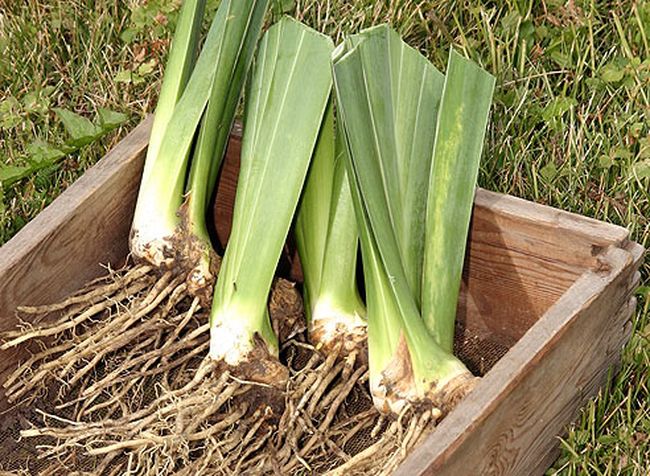

Pests of Siberian irises
The plant has pests that feed on its juice and molding. They cause iris disease or death. The list of insect pests includes:
- Slugs
... The worms are activated at night and feed on the stems and leaves of the plant. To protect the culture in the ground, ash or treat the flower with a tincture of bitter pepper. - Aphid
... The insect drinks the sap of the plant and causes it to dry out. Siberian iris Cambridge and other varieties are sprayed with soda (0.5%) or karbofos (0.3%) to protect against pests. - Thrips
... To combat the pest, summer residents use karbofos diluted in water in a ratio of 75 g per 10 liters. - Nematodes
... Insects survive even during the cold season. To combat the problem, the garden tools are processed with formalin and the weeding of the summer cottage is carried out.
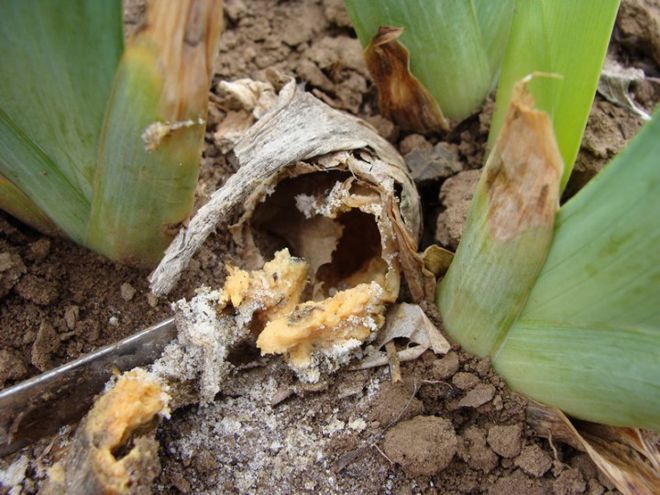

Highly decorative varieties of irises
The most exquisite and extraordinary irises, decorated with fringe, small and large. Will be the perfect decoration for any garden.
Blackberry jubilee
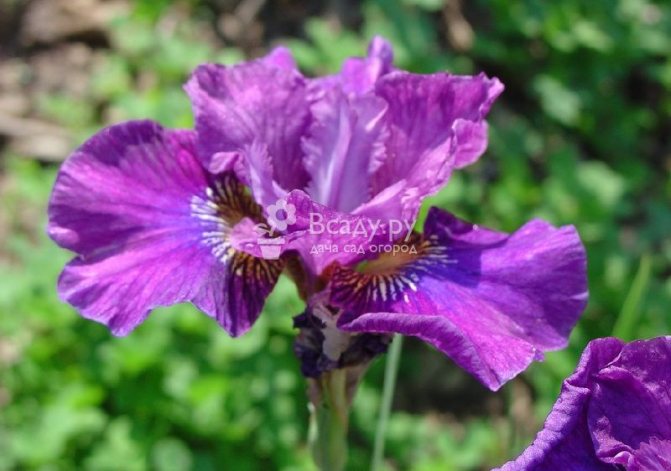

Most disease resistant. The flowers are huge and corrugated, painted in red-violet color with a pale yellow core. Plants bloom late, but they delight with their flowering for two months. It takes root on any soil and prefers lighted flower beds.
Coronation anthem
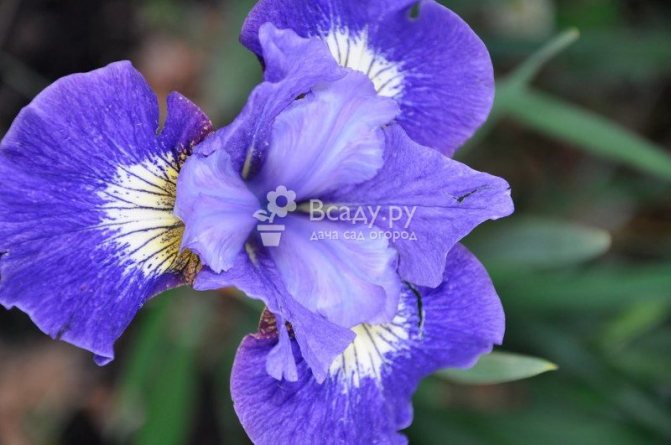

Irises of the photo variety and the description of which we have already considered, almost all bloom once. But the massive and tall Siberian species Coronation Anthem can bloom repeatedly. Up to two stems emerge from each seedling with 4-5 ovaries of blue flowers with a yellowish center.
Crimson cloisonne
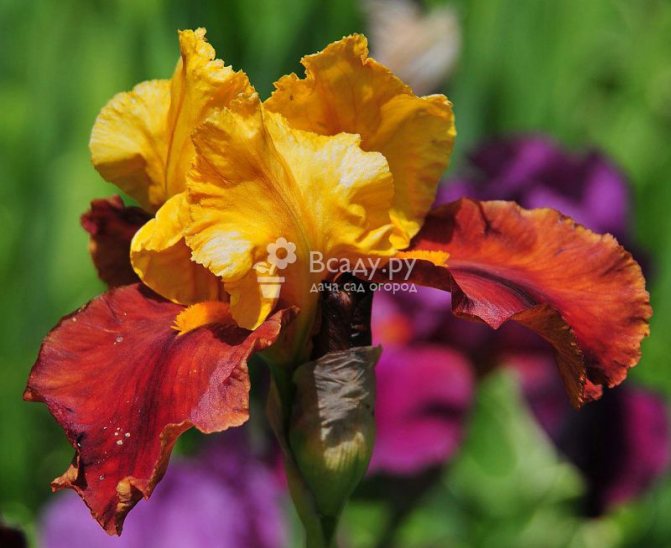

One of the newest, late and, on top of that, capricious varieties. Large burgundy flowers with lilac veins and a yellow center appear only in June. They are comfortable in shaded cool areas.
Dance and sing
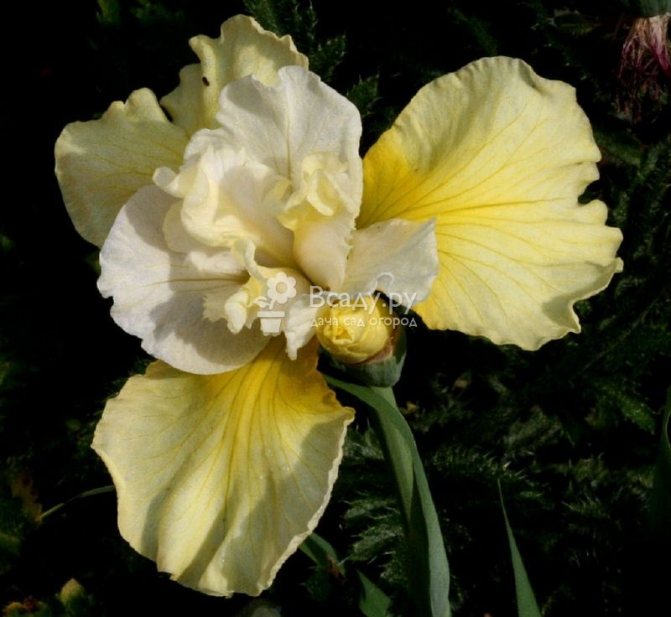

Fragrant and amazingly beautiful iris with giant light yellow flowers. Ideal for breeding among stunted carpet plants. Bright sunlight, light shading in intense heat, abundant watering - all that is needed for its growth.
Dawn waltz
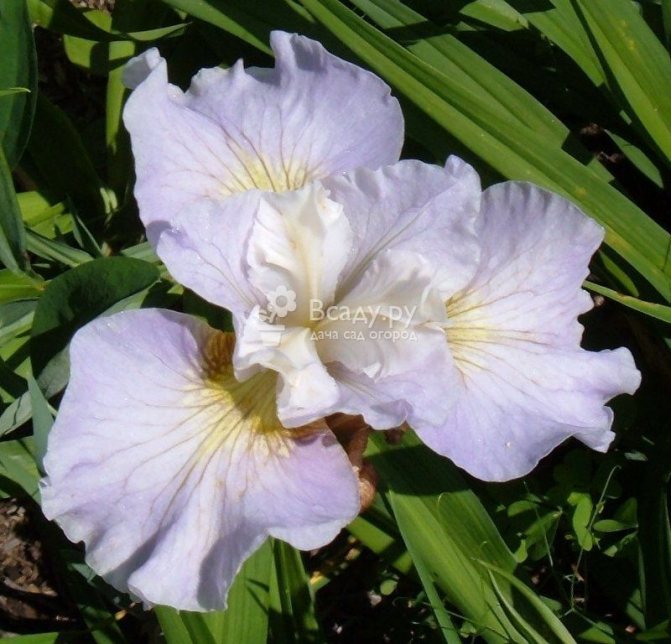

Delightful tall flowers with strong leaves and stems, large, light purple inflorescences and a pale yellow heart. The main feature is a very long (up to two months) flowering with a sufficiently moist and fertilized soil.
Double standards
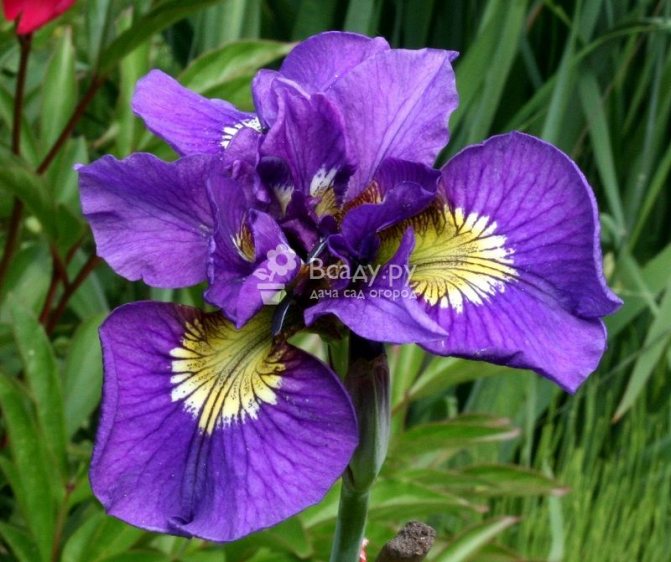

Resistant to cold, grows up to about 65 cm and attracts attention with their large bright buds of dark purple color. Funny yellow centers make them really delicate and charming. They need neutral soil and frequent watering, especially in the first year of life.
Kaboom
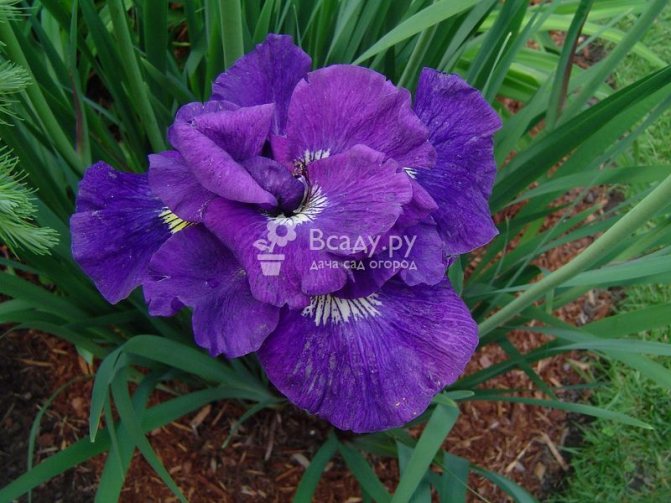

When listing the most fastidious varieties of irises, the first thing to remember is the Siberian Kaboom. It can grow up to 70-80 cm with lush double flowers in a deep blue-purple color with a raspberry tint, if you pay enough attention to watering and fertilization.
Outcome
Before you start planting flowers, the first and most important step is choosing varieties. This is especially true for areas with unstable or special climatic conditions.If this issue is incorrectly approached, the care and cultivation of irises and any other flowers can be too difficult and costly. Also, in most cases, improperly selected plants die.
Having considered the most famous and popular varieties of irises for northern latitudes, photos with the names of which will help when purchasing in nurseries, everyone will certainly want to decorate their garden with such a stunning fireworks of rainbow shades. And this is the right decision, since caring for these plants will take a little time, and in return will give you a lot of pleasure. When growing flowers in the garden, do not forget about preventive methods of treatment against pests, and they will delight you with their variegated petals for a long time.
Why do the buds of Siberian iris dry up?
Another problem that summer residents may encounter is the blackening of the inflorescences of the bush. They do not have time to bloom and immediately fade. Drying of buds occurs for two reasons: infection with root rot or damage to the shrub by insects. The grower needs to break the flower and examine it for pests. All damaged inflorescences are cut and destroyed. A sick specimen is treated with insecticides to avoid problems the next year.
If there are no insect larvae in the inflorescences, this means that the flower is infected with root rot. A sick specimen is sprayed with any fungicide. Siberian iris Miss Apple and other varieties can be saved with Glyokladin. Several tablets of the drug are buried under each affected bush. When controlling root rot, it is also important to reduce the frequency and amount of watering.
Diseases and pests
The more elegant and colorful the flowers of the irises, the more susceptible they are to diseases and pests. To maintain plant health, it is necessary to follow the rules of care and constantly monitor the condition of the plants. Having discovered the problem in a timely manner, the gardener can easily cope with it, preserving the life of his plants.
Irises can suffer from various types of rot, including Fusarium. In order to prevent the disease from spreading to all plants, immediately after the problem is detected, diseased specimens should be dug up and burned. For prevention, the roots of healthy flowers are treated with a 2% fungicide solution.
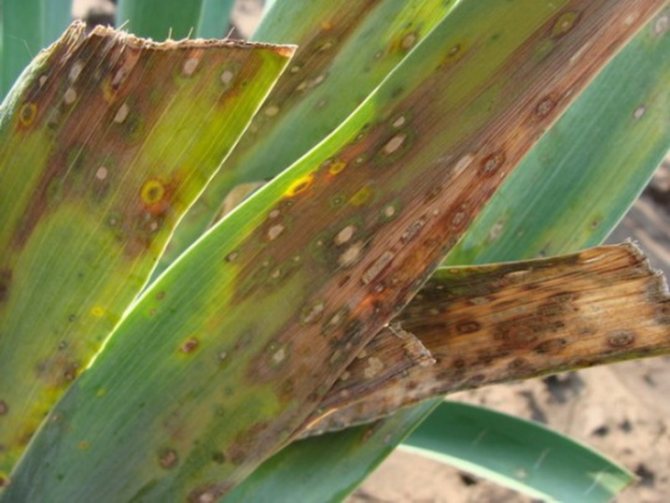

Irises are often attacked by thrips. These insects harm the flower by destroying the pigment cells in the leaves, as a result of which the plant stops photosynthesizing. Thrips most often attack plants during dry periods. You can fight the parasite with the chemical malathion. There is also a home method of getting rid of thrips: plants must be treated with a solution consisting of 100 grams of tobacco and 10 grams of grated laundry soap, dissolved in 1 liter of water.
The bright flowers attract a variety of insects. The pests that infect irises include worms that feed on the base of the peduncles. To protect the irises from the attack of worms, the plants during the growing season must be treated twice with a 10% solution of karbofos. There should be a one week break between treatments with this antidote.
Another pest that a grower may encounter while growing irises is a slug. Try to get rid of the parasite as follows: put damp rags between the leaves of the iris bushes, which the slugs will take for cover. This way, by simply folding the rag, you can easily get rid of a lot of slugs.
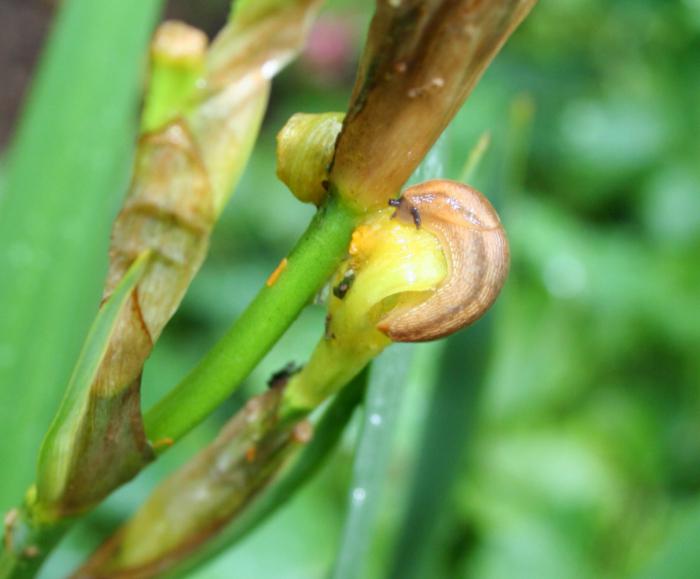

Siberian iris in landscape design
The culture has more than 100 varieties, differing in height and color. Siberian iris is used to decorate flower beds or mixborders. At the same time, undersized specimens are placed in the foreground, and tall bushes with a length of 1.4 m or more are placed in the background. Graceful plants will adorn any reservoir, because they harmoniously merge with coastal vegetation.
After flowering, it is not necessary to cut the seed pods from the irises. The bushes add extra interest to the landscape design.In large rockeries, irises are planted in groups of the appropriate shade. Small suburban areas are decorated with miniature specimens. In order for undersized varieties to grow, they must be transplanted and divided more often.
Requirements for conditions
Let's find out in what conditions it is best to grow Siberian iris.
Region
Siberian iris is one of the few ornamental plants that can be successfully cultivated in almost any region of Russia. The flower grows well both in the south and in the north, as evidenced by its very name.
Lighting
Iris is a light-loving culture. This parameter is of particular importance when growing a flower in the north. It is recommended to choose the most open and well-lit areas of the garden for it.
Direct sunlight, however, the delicate petals of the plant are difficult to tolerate, they can burn. Therefore, it is better to choose even a well-lit place, but with diffused light.
Siberian iris varieties can grow in the shade, however, due to lack of sun, their flowering will not be decorative. The lower the light level, the poorer and finer the flowering of the plant.
Drafts
Siberian iris grows well, even when blown by the winds. In this case, there is nothing to be afraid of drafts, you can stop in a completely open area.
Soil composition
The flower can thrive in almost any soil. And even in the most infertile and poor soil, you can easily compensate for good care.
However, excessively acidic soil should be avoided, as well as too alkaline. It is recommended to make very poor soil more nutritious before planting irises by applying fertilizers.
Soil with good permeable characteristics, which has a slightly acidic or neutral reaction, is best suited for Siberian iris. The best option is loam with an admixture of humus.
Attention: irises can grow in one place from 10 to 12 years. Then you need to divide the rhizomes and transplant.
Related videos:

